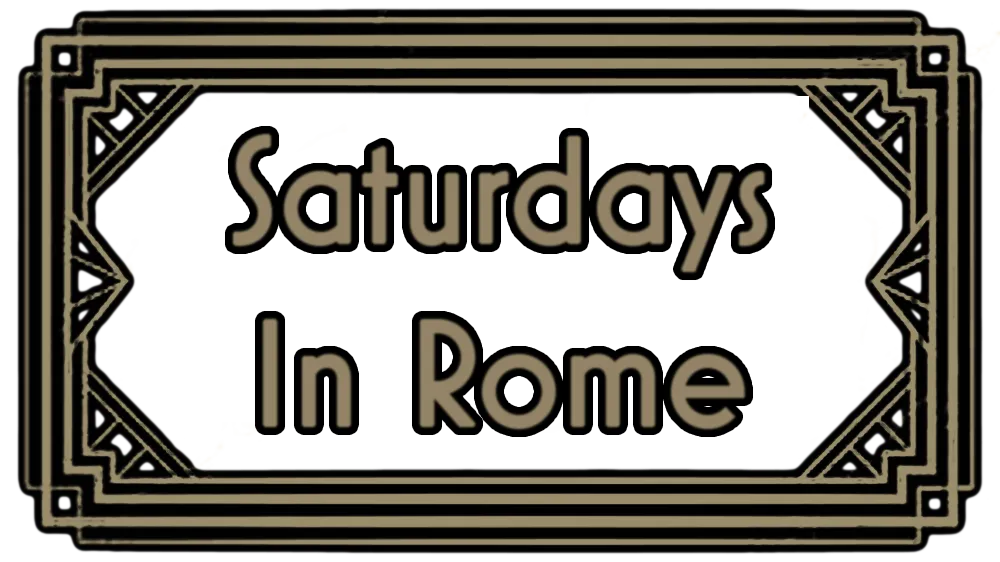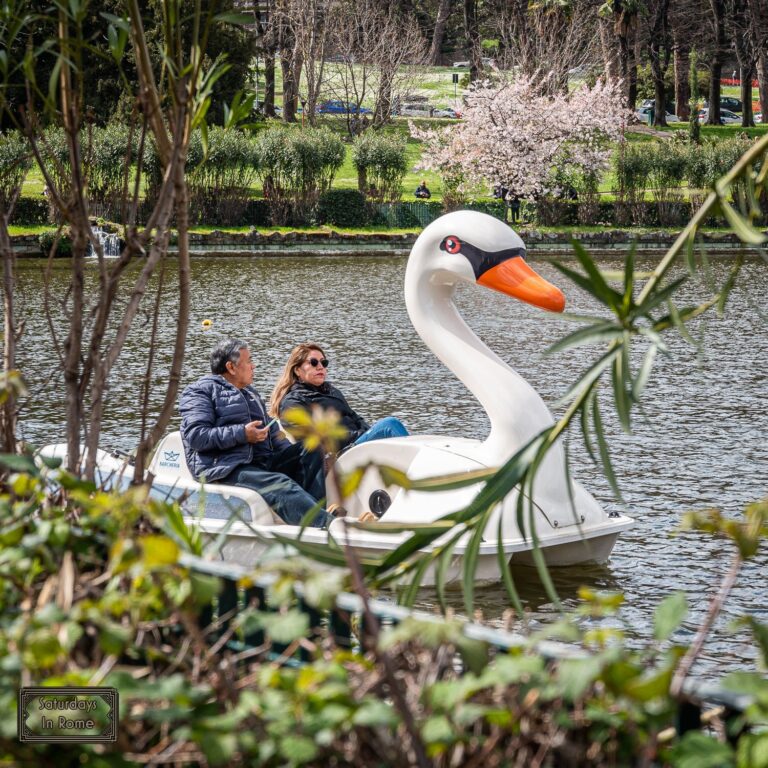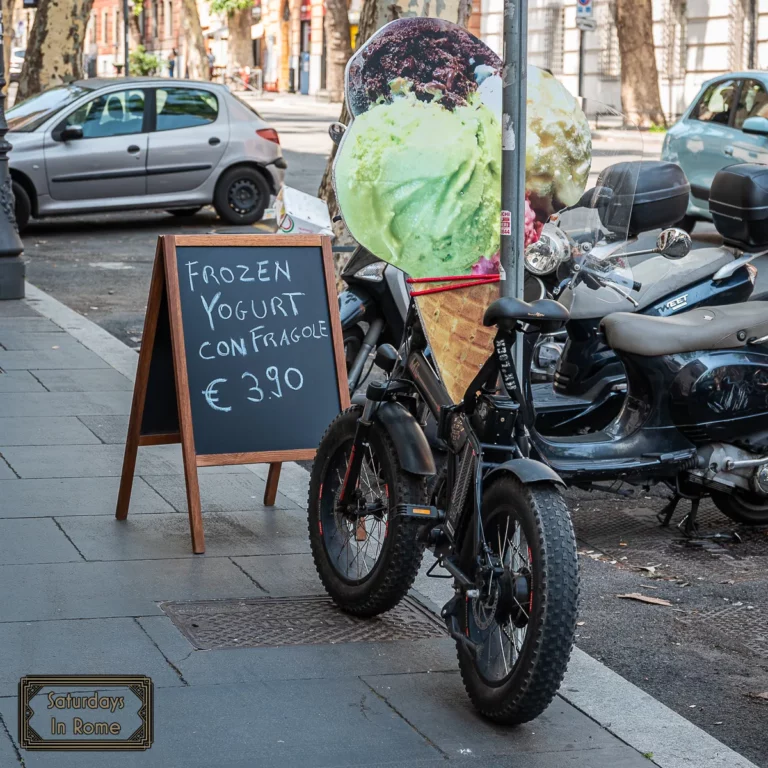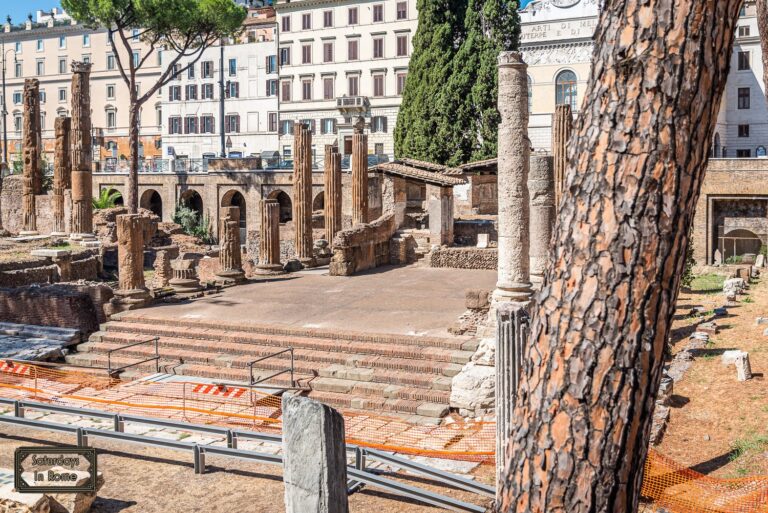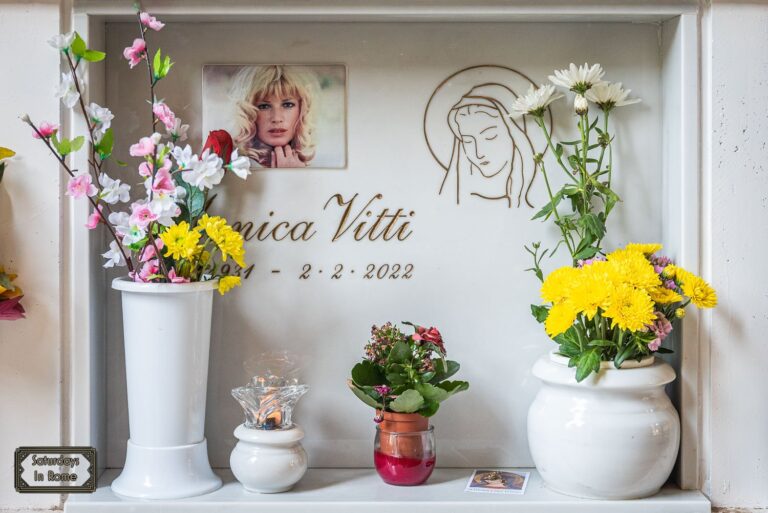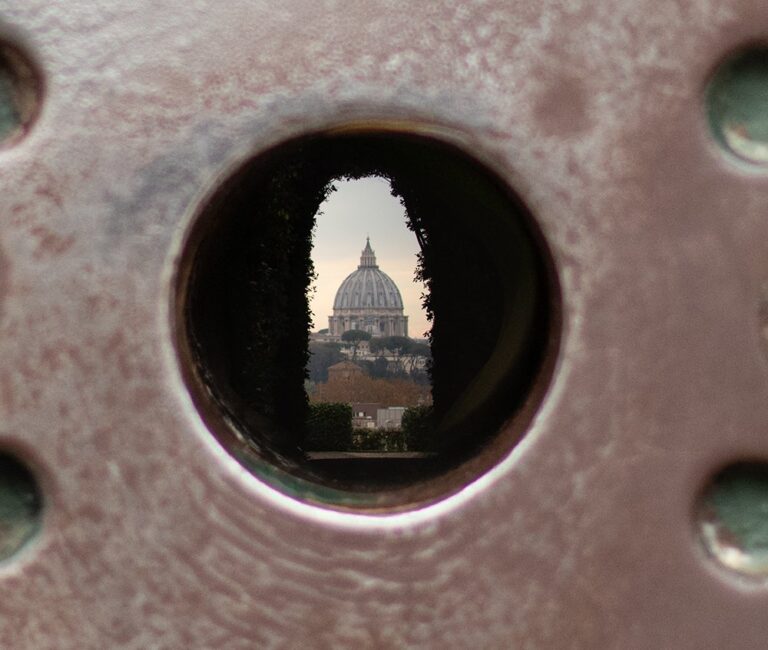The Seven Pilgrim Churches Of Rome Are A Way To Connect
The seven pilgrim churches of Rome offer a way for Catholics visiting the city to take part in the tradition of visiting the churches as a way to connect.
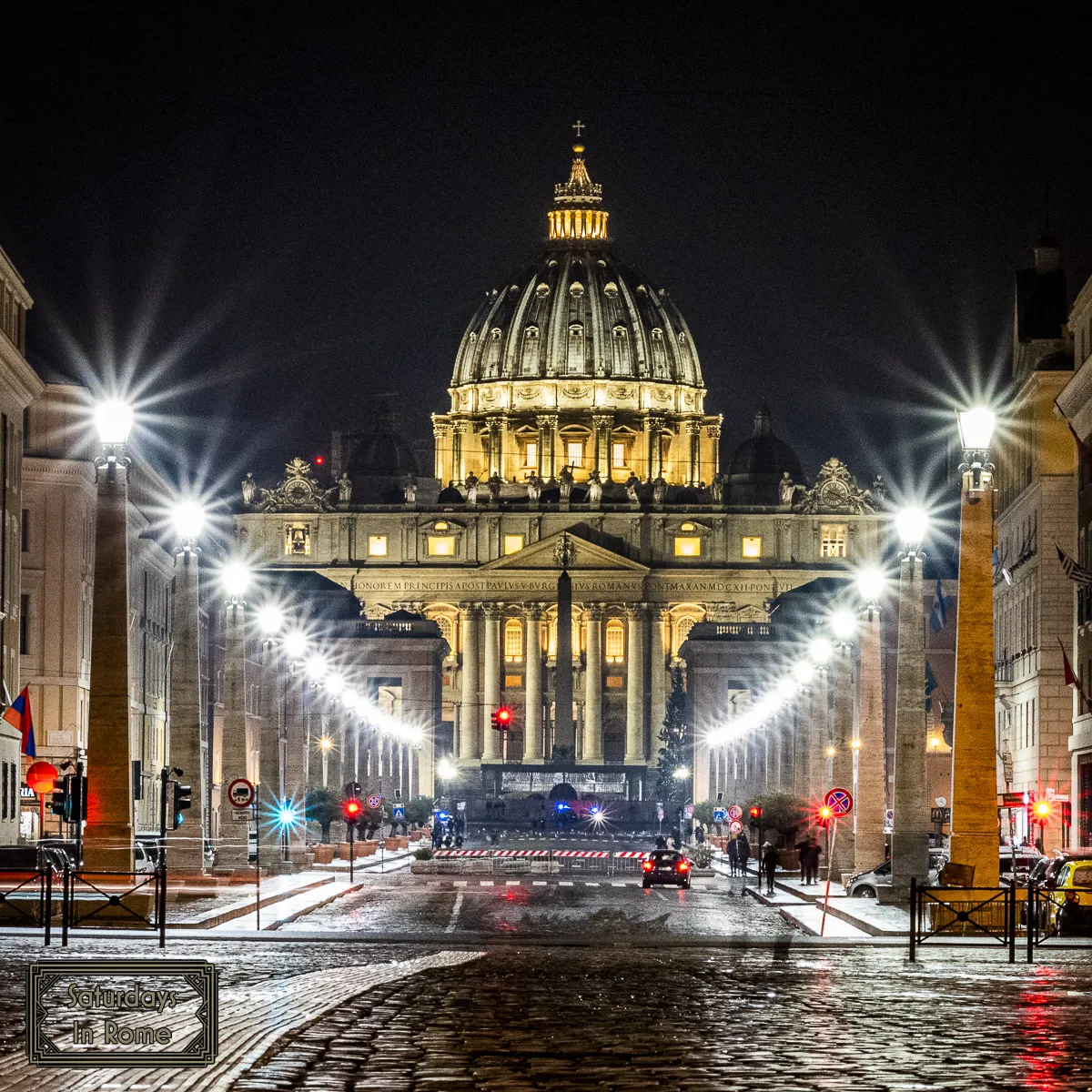
What Are The Seven Pilgrim Churches Of Rome?
The tradition of visiting all seven churches was started back in the 16th century in order to combine conviviality and the sharing of a common religious experience through the discovery of the history of the early Saints. In the beginning, a few friends and acquaintances would gather before dawn and set out on their walk. At each church, there would be prayer, hymn singing, lunch breaks and a brief sermon. The path covers twelve miles in Rome, but if you aren’t interested in walking that far, public transportation and taxis can make the journey that much easier.
Need Help Planning?
- Cheap Flights: Find The Most Affordable Flights.
- Accommodations: From 1 to 5 Stars And More.
- Car Rentals: Affordable Travel Across Italy.
- Sightseeing Tours: Explore Some Amazing Tours.
- Buying An eSIM: Stay Connected In Italy.
This post includes affiliate links.
The Seven Churches Visitation is a Roman Catholic tradition to visit seven churches on the evening of Maundy Thursday during Lent, but it is also done on Wednesday of Holy Week. During the Seven Churches Visitation, the faithful visit several churches to pray before the Blessed Sacrament in each church. Depending on the timing, you might encounter church services that you can either attend or wait until they are finished, before you can have a detailed tour of the church.
The Vatican And St. Peter’s Basilica
Saint Peter’s Basilica is the largest church in the world, and the most important one in the Catholic world. It unites the religious faithful and lovers of art and is a major pilgrimage site for the Catholic faithful. It frequently draws crowds of tens of thousands, both in the basilica and its adjoining St. Peter’s Square, which are used for a number of masses and celebrations during the year that are presided over by the pope.
St. Peter’s Basilica is free to enter and open everyday, from April to September from 7:00 am to 7:00 pm, and from October to March from 7:00 am to 6:30 pm.
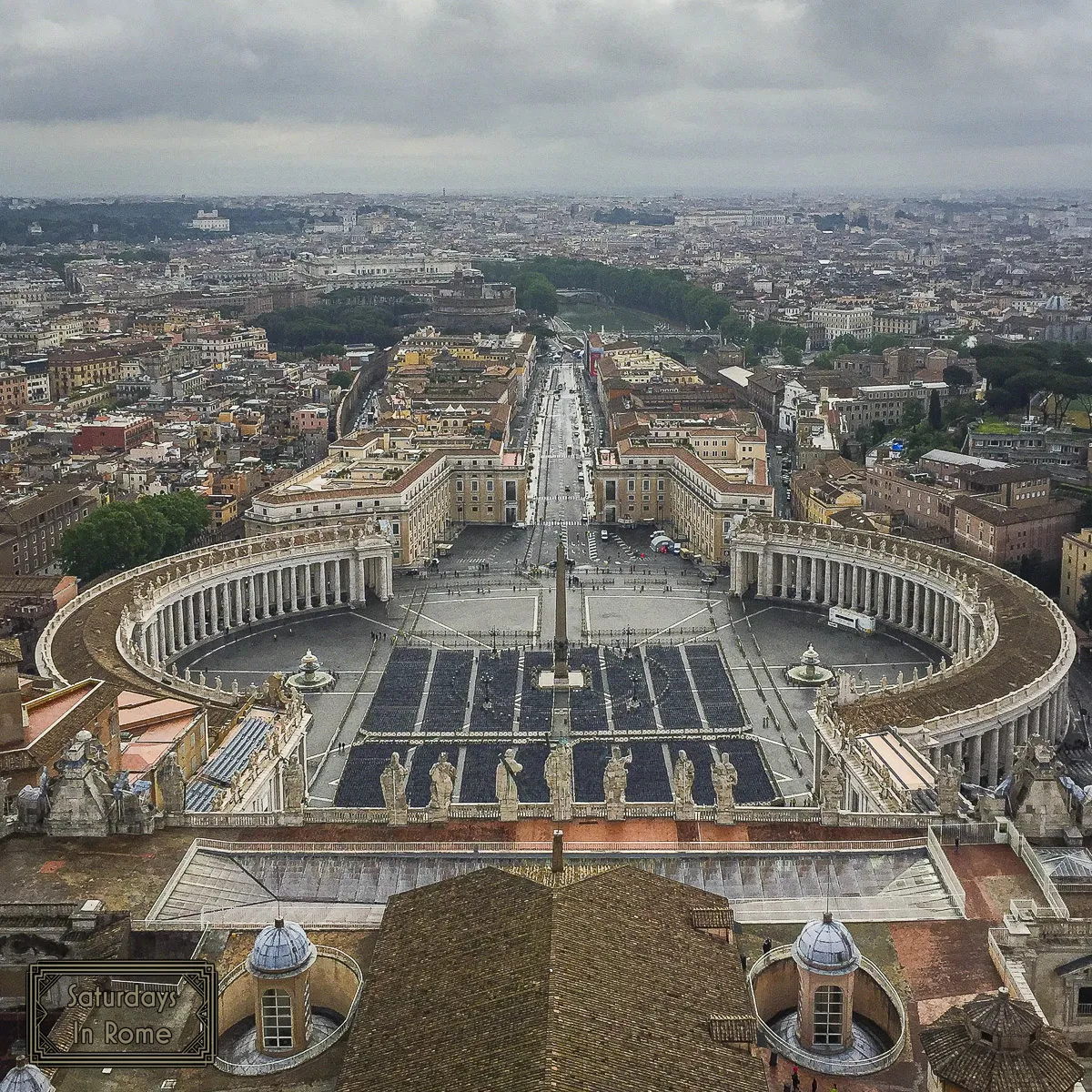
Vatican City Dress Code
The Dress Code of Vatican City is strictly enforced at St. Peter’s Basilica. No shorts, bare shoulders or miniskirts. This applies to both men and women. I’ve entered with shorts on, but I’ve heard it is possible to be sent away, even if you got through security. The other important item during the summer is a hat, but from personal experience these are not allowed for men.
The Vatican City Basilica Cupola
Climbing the Cupola, as seen in La Dolce Vita, is something that shouldn’t be missed if you can handle cramped spaces and a lot of stairs, because the views are amazing. The hours from April to September are 8:00 am – 6:00 pm. From October to March, 8:00 am – 4:45 pm. The cost is €10 if you want to use the elevator and only €8 if you can brave the stairs.
Visiting The Vatican
There is what seems like an unlimited number of tour operators selling tours online which is a testament to the popularity and importance of the Basilica. It is free to enter the Basilica, but the lines are unimaginable, so you need to get there early, or better yet, off-season.
I recommend that you purchase audio tours of the Basilica or simply download the Rick Steves app, which contains tours of the Sistine Chapel, St. Peter’s Basilica and the Vatican Museums. These tours will help get a handle on all of the beautiful artwork and architecture throughout the Basilica.
The Papal Archbasilica Of Saint John in Lateran
This Catholic church in Rome goes my many names: Archbasilica Cathedral of the Most Holy Savior and of Saints John the Baptist and John the Evangelist in the Lateran (Arcibasilica del Santissimo Salvatore e dei Santi Giovanni Battista ed Evangelista in Laterano), the Papal Archbasilica of Saint John in Lateran (Arcibasilica Pontificia di San Giovanni in Laterano), Saint John Lateran (San Giovanni Laterano), or the Lateran Basilica (Basilica Lateranense).
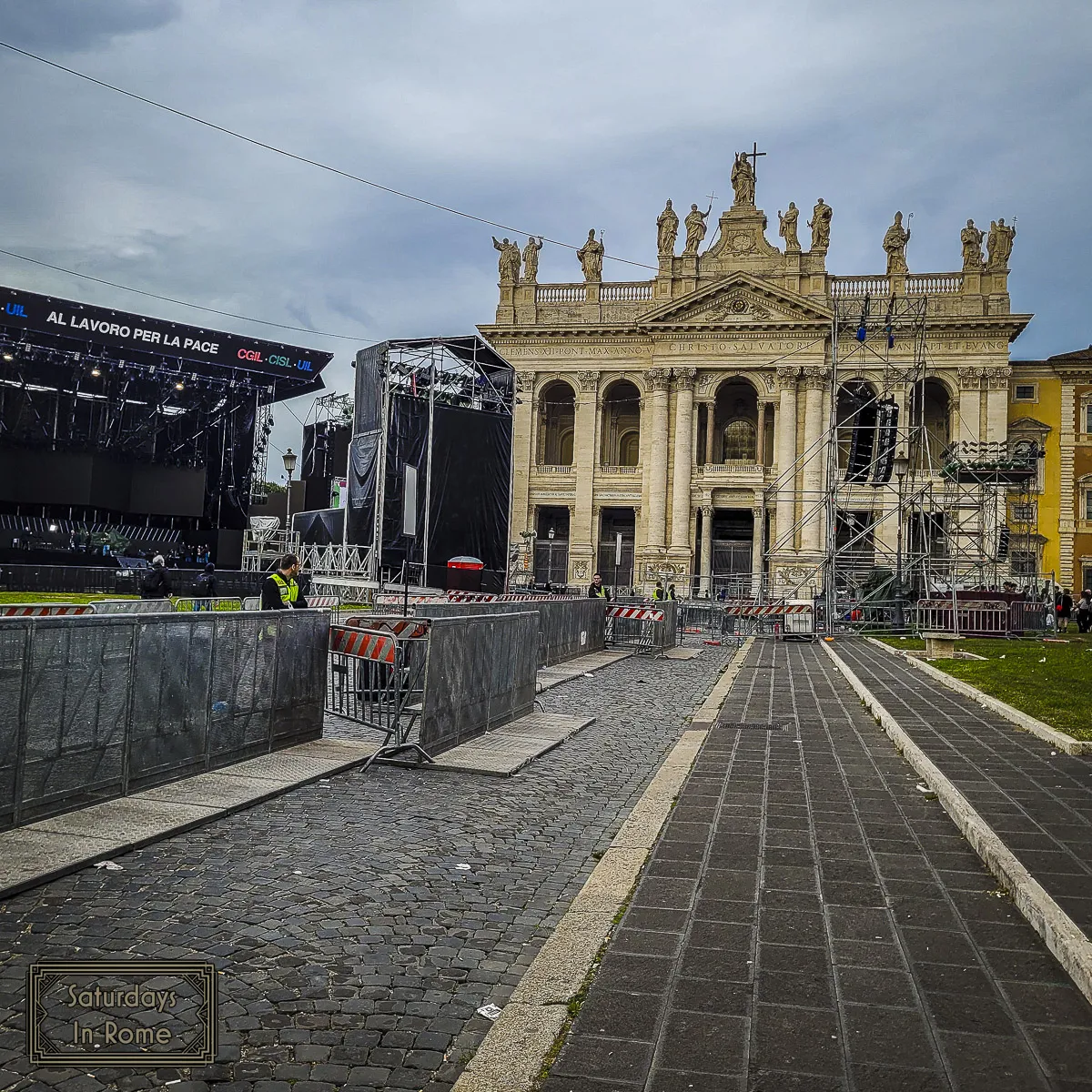
This cathedral church, which is part of the Diocese of Rome, serves as the seat (think: headquarters) of the bishop of Rome, also known as The Pope. This Rome church is outside of Vatican City, however, as properties of the Vatican, the church and its offices have a unique status from Italy, pursuant to the terms of the Lateran Treaty of 1929. In short, From the time that the country was unified in 1861 until the signing of The Lateran Treaty between the Holy See (i.e. Vatican) and the Kingdom of Italy, the situation was unclear and the influence the Vatican had over some or all of Italy was referred to as the “Roman Question”
This ambiguity became clearer on February 11, 1929 when the Lateran Treaty between the Holy See and the Kingdom of Italy was signed by Mussolini on behalf of King Victor Emmanuel III and by Cardinal Secretary of State Pietro Gasparri for Pope Pius XI. The treaty created the independent state of Vatican City.
The Restoration Of San Giovanni In Laterano
The Basilica was founded in 324, it is the oldest public church in the city of Rome. Over the centuries, the church has survived several fires and an earthquake in 897. It still maintains its original form despite being reconstructed several times.
The building deteriorated during the Middle Ages and was badly damaged by two fires in the 14th century, but it was rebuilt in the late 16th century during the reign of Pope Sixtus V. The new structure’s interior was renovated in the late 17th century, and its façade was completed in 1735 under Pope Clement XII.
The Lateran Palace
The church, which is the oldest church in Europe, stands on the remains of a fort built by Spetimus Severus (not Snape) in 193 AD and after it was razed, and it was handed over by Constantine I to the Bishop of Rome, who converted the building from a palace that honored the wife of Constantine I, into a temple during the fourth century.
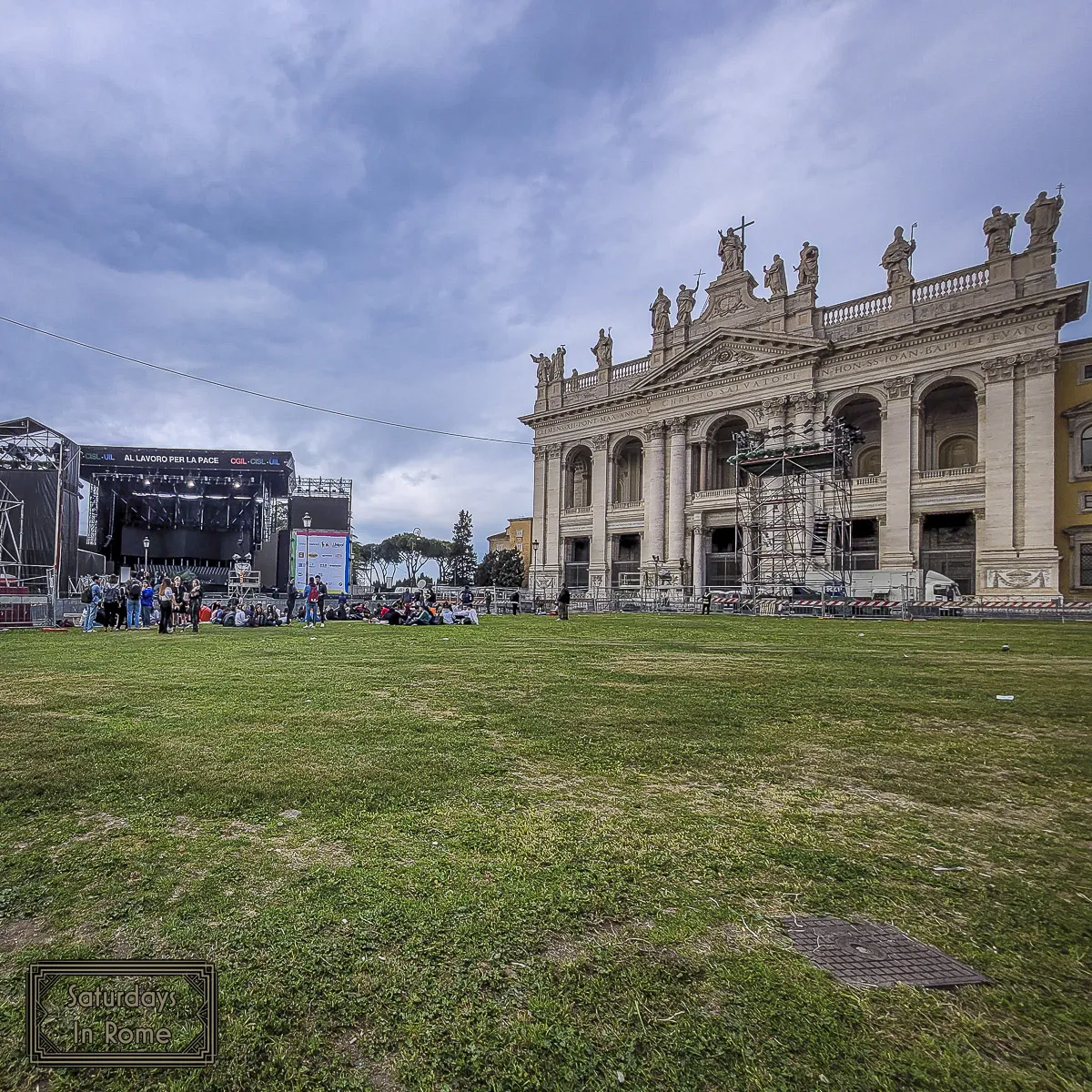
The Basilica of St. John Lateran continues to have an important role in history. All popes were enthroned in this church up until 1870. Today, Basilica di San Giovanni in Laterano is where the Pope, as Bishop of Rome, celebrates Holy Thursday Mass.
What Is In The Neighborhood Of San Giovanni
This area of Rome is less touristy as compared to the area around the Vatican. From a religious perspective, the other major part of the Pilgrim Trail is right across the street from the basilica, and those are the Holy Stairs (Scala Sancta). These are so important that I will soon be having a separate post solely on this topic, but the quick version is that these are thought to be the stairs that Jesus climbed on his way to his trial during his Passion. Again, more on this later.
Not far from the basilica you can visit other monuments and churches. Among these: the Basilica of Santa Croce in Gerusalemme, which is mentioned above as one of the seven pilgrim churches in Rome and houses the relics of the Cross brought to Rome by Saint Helena. Somewhat less religious but very tranquil is Villa Celimontana, a lovely green space near the Colosseum and an ideal place for outdoor breakfasts and walks; the Basilica of San Clemente. The church of Santo Stefano Rotondo is also very close, albeit a bit hidden.
San Giovanni Cultural Relevance
Although less of a tourist site and more of a cultural touchpoint, the neighborhood is connected to two of the most popular and influential Italian actors ever to grace the screen. The great actor Alberto Sordi, while born in Trastevere, has a museum in the area whose purpose is to take care of his important legacy and keep the memory of Alberto Sordi alive. Similarly, Marcello Mastroianni grew up in the San Giovanni district, although he was born outside of Rome in the Apennine Mountains.
Shopping
Beyond the Porta San Giovanni, which is one of the doors that open into the Aurelian Walls of Rome, is the beginning of one of the main shopping streets of Rome, via Appia Nuova. The large street is lined with shops for all tastes and budgets.
Workers’ Day In Italy
One of the fun surprises I experienced this past May was a concert held on the front lawn of the basilica. In the main square in front of the basilica on the 1st of May, there is a famous concert held annually to celebrate Workers’ Day, also known as May Day and Labor Day. In 2022, this traditional concert to celebrate Workers’ Day in Italy returned for the first time in two years because the free concert was canceled in 2020 due to the pandemic. The concert is organized by the trade unions, so it is also used as a platform to promote workers’ rights.
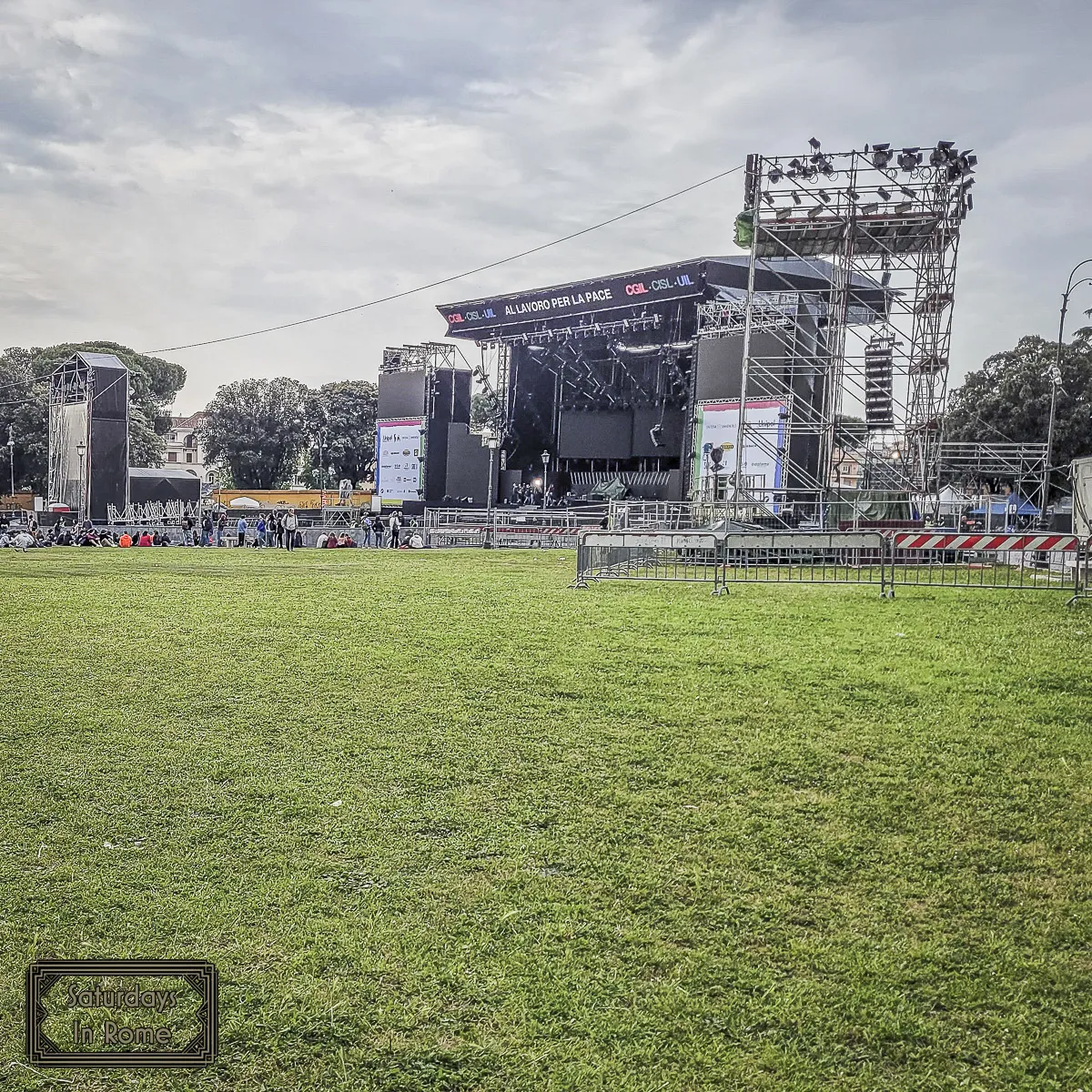
How To Get There
There are a number of very good options that you can take advantage of when trying to reach the Basilica. There is a San Giovanni stop on the Metro B subway. There is a fairly big bus stop where you can take the #16, #81, #85 or the #87. There is also the #51, which takes passengers on a loop between San Giovanni and Largo Chigi, going through Piazza Venezia and by the Colosseum.
The Basilica Of Saint Mary Major
Built on the summit of the Esquiline Hill, the Papal Basilica of Saint Mary Major (Basilica Papale di Santa Maria Maggiore) is one of the four major papal basilicas in Rome (St. Peter’s Basilica, St. Johns and St. Paul are the other three), and among these basilicas, St. Mary Major is the only one to have kept its original structure, though it has been updated and expanded over the years. It is also one the seven pilgrim churches of Rome, which I’ve detailed below.
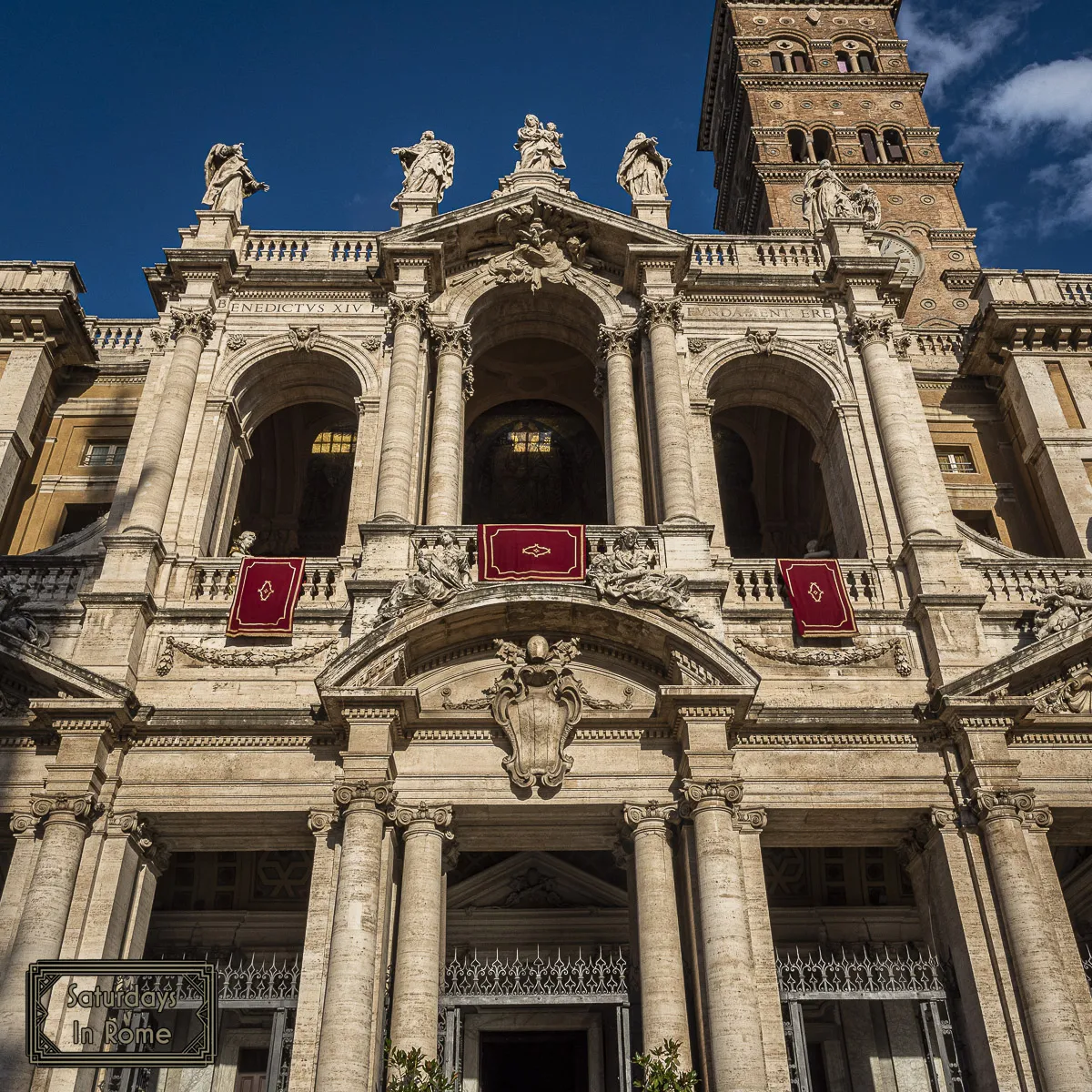
The Location Of St. Mary’s Basilica
Tradition has it that the location of the Basilica of Santa Maria Maggiore was chosen because it was the site where the Virgin Mary appeared in a dream to Pope Liberius in which she asked that the church be built in that location in her honor.
Why Is It Called Saint Mary Major?
Since its creation, the building on the site of Basilica of St. Mary Major has gone by many names. It was known at the Liberian Basilica and Santa Maria Liberiana in reference to Pope Liberius’ vision. It was known as Saint Mary of the Crib (Sancta Maria ad Praesepe) because of a relic from the nativity crib that was brought to the church.
Another name sometimes used is Our Lady of the Snows. This is in reference to another vision of the Virgin Mary and a snow that fell on Esquiline Hill in August, at the height of summer. It maintains the name Major because of its important status as a major papal basilica, even though including Major in the title is not used more widely.
The Sistine Chapel
This is not the most famous Sistine Chapel in a Rome Basilica that you can enjoy when you visit the Vatican Museums or if you are allowed to elect a new Pope. That one was built at the request of Pope Sixtus IV around 1473. This Sistine Chapel was built at the direction of Pope Sixtus V more than 100 years later and contains his tomb.
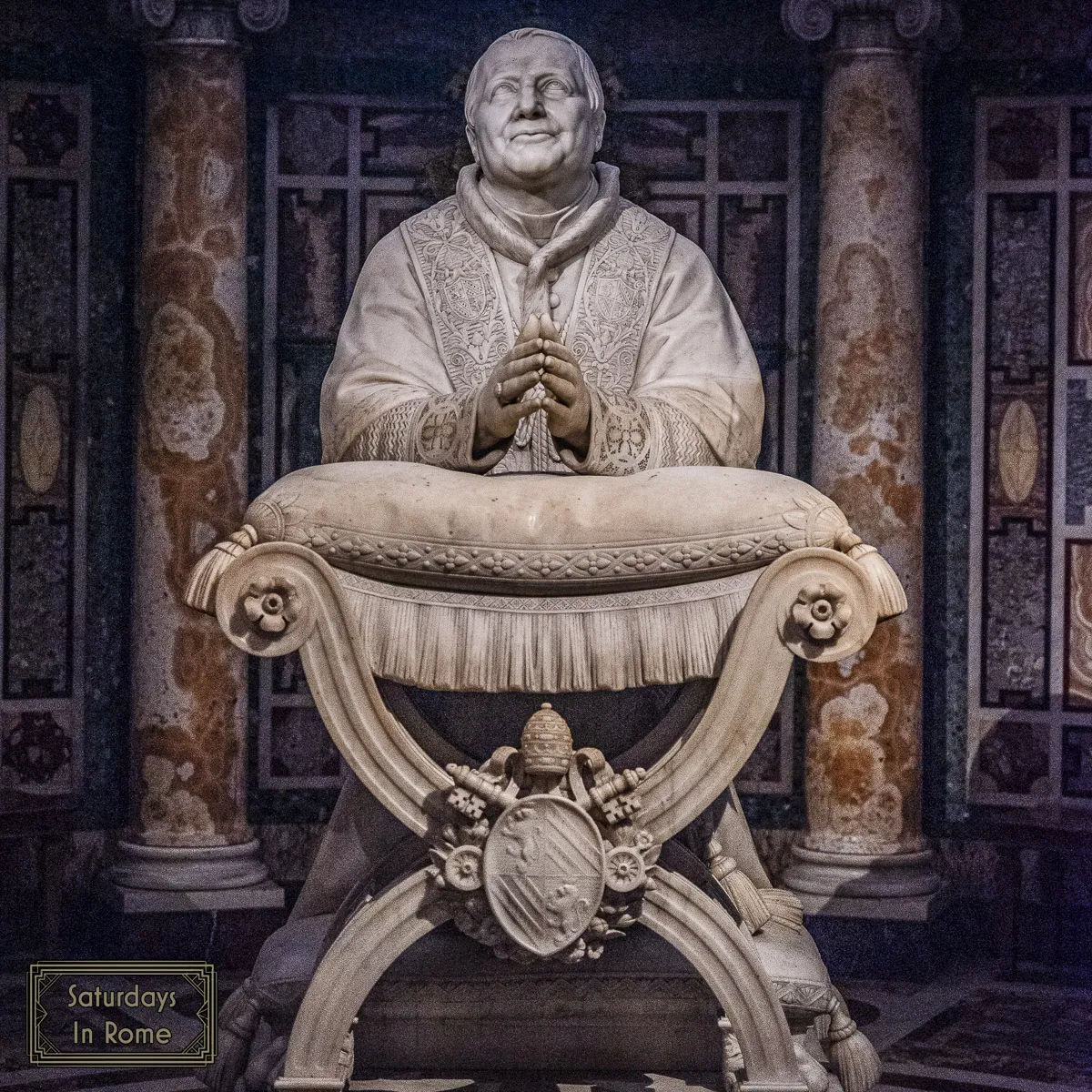
Is The Church Of Saint Mary Used By The Pope?
Since the Basilica of Saint Mary Major is a papal basilica, it is used by the pope on occasion. He presides over the annual Feast of the Assumption of Mary on Ferragosto. The canopied high altar is reserved for use by the pope alone. The pope gives charge of the basilica to an archpriest, usually a cardinal.
Who Is Buried In Rome’s Santa Maria Maggiore?
Being such an important religious site, there is a long list of Popes and other dignitaries that call Saint Mary’s Basilica their final resting place. Among the Popes interred here are:
- Pope Sixtus V
- Pope Clement VIII
- Pope Honorius III
- Pope Clement IX
- Pope Nicholas IV
- Pope Pius V
Other Notable Perpetual Residents
Gian Lorenzo Bernini – The leading Italian sculptor and architect of his time. His art is found all over Rome and in particular at the Borghese Museum due to his relationship with the powerful Cardinal Scipione Borghese and his uncle Pope Paul V (formerly known as Camillo Borghese).
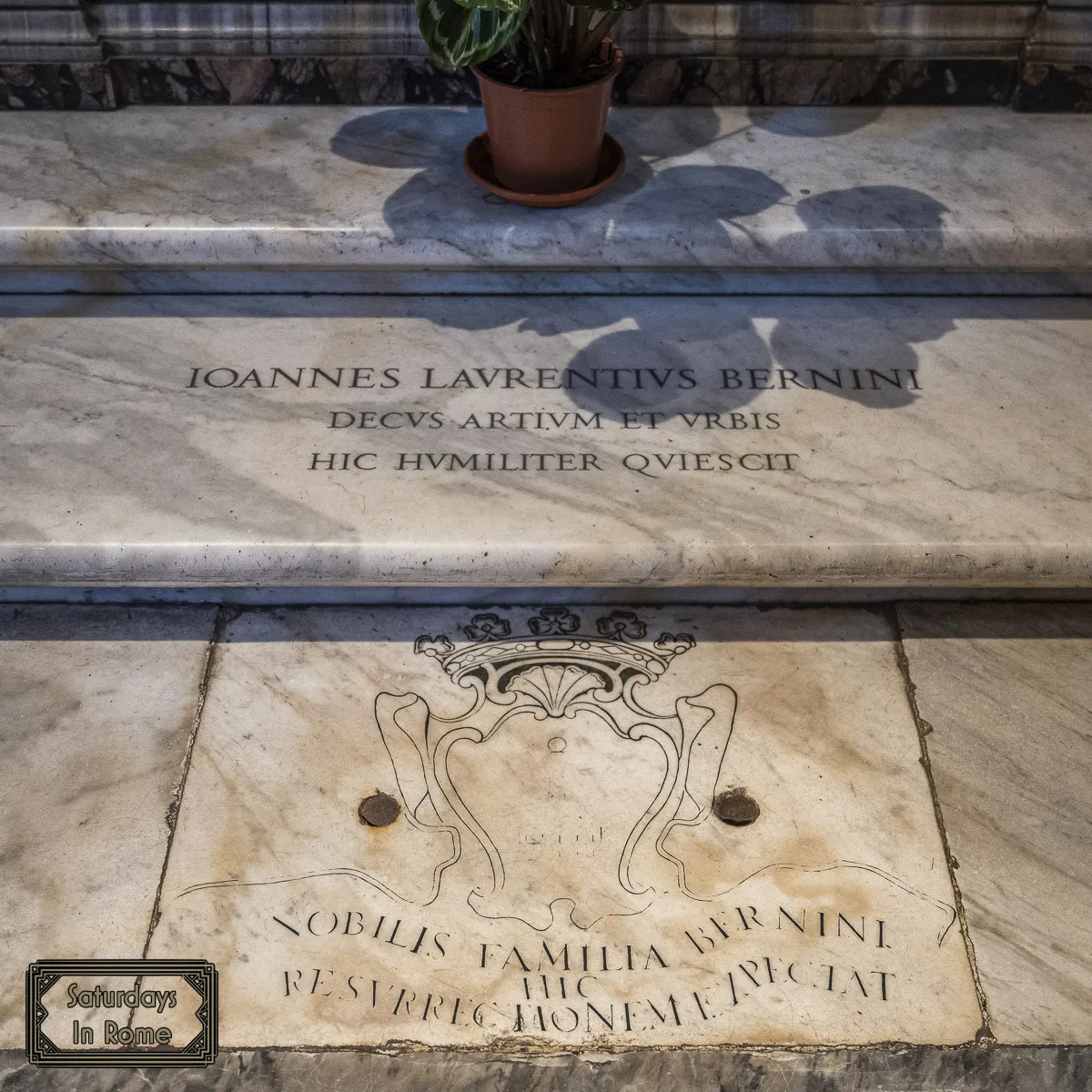
Pauline Bonaparte – The younger sister of Napoleon, her second marriage was to another Camillo Borghese (i.e. not Pope Paul V).
Junio Valerio Borghese – Another member of the House of Borghese, this delightful gentleman, nicknamed The Black Prince, was a Navy commander during the reign of Benito Mussolini and the Fascists. He was a prominent hardline Fascist politician and in 1970 he took part in the planning of an aborted neo-fascist coup and he escaped to Spain where he spent the remaining years of his life.
How To Visit The Basilica Of Saint Mary Major
If you want to visit The Basilica of Saint Mary, you are in luck because it is very centrally located at: Piazza Santa Maria Maggiore, which is only a couple of blocks from the Termini train station. You can reach Termini Station on Metro A or B at the stop named Termini. You can either walk or take the ATAC buses: #714, #360 or #649. There is also a taxi stand at Termini if the bus isn’t your style.
The Visiting Hours For Santa Maria Maggiore
When visiting Saint Mary’s Basilica, please be aware that there is a dress code. You are requested to wear appropriate clothing that covers the shoulders and knees. While this is generally the rule at all houses of worship, and in particular at the major basilicas, it is worth noting that my experiences during the summer have been a bit more flexible. Men definitely can’t wear hats, but wearing shorts didn’t seem to be much of a concern. I’ve noticed similar flexibility with women as well.
The basilica is popular with tourists and pilgrims alike, so be prepared for long lines if you are visiting during the summer at popular times. I recommend getting there early as the hours for the Basilica are: daily from 7:00 am to 6:45 pm. On Sundays and feast days it is open from 9:00 am until noon.
How To Get Tickets For Santa Maria Maggiore
There are no tickets needed to visit the Basilica of Saint Mary as entry is free. It is a working church, however, so expect to have to wait to enter if a mass is being celebrated.
The Basilica Of Saint Lawrence Outside The Walls
The Basilica of Saint Lawrence Outside The Walls (Basilica Papale di San Lorenzo fuori le Mura) is one of Rome’s minor papal basilicas, as well as being one of the Seven Pilgrim Churches of Rome. It is outside of Rome’s large and historic Verano Cemetery (Cimitero del Verano) and is a shrine to its namesake, San Lorenzo.
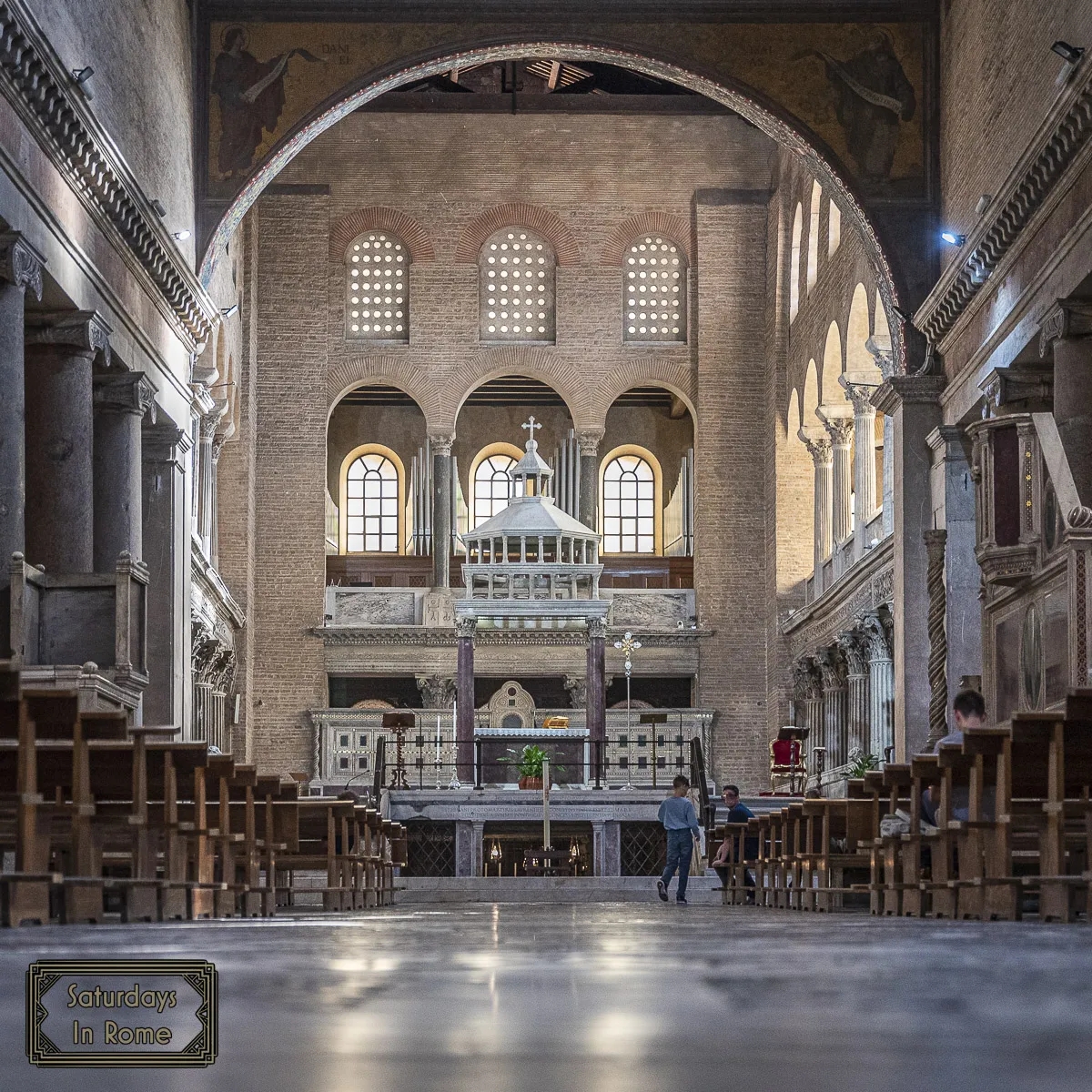
The Patron Saint Of Chefs
St. Lawrence was strapped to the top of an iron grill over a slow fire that roasted him alive. The legend is that God gave him so much strength that Saint Lawrence was able to joke with his captors while he died. In addition to chefs, it is also claimed that St. Lawrence is the patron saint of comedians, as well.
Becoming The St. Lawrence Catholic Church
An early version of the basilica was built in the 4th century by Emperor Constantine I near the tomb of the martyr Lorenzo. Major expansion began in the 13th century when this new basilica was decorated with frescoes of San Lorenzo and Saint Stephen, who was the first Christian martyr. There were continued transformations of the church through the 19th century, and in 1943, the Basilica was bombed by the Allied forces and restoration continued until 1948 with further transformation of the original structures.
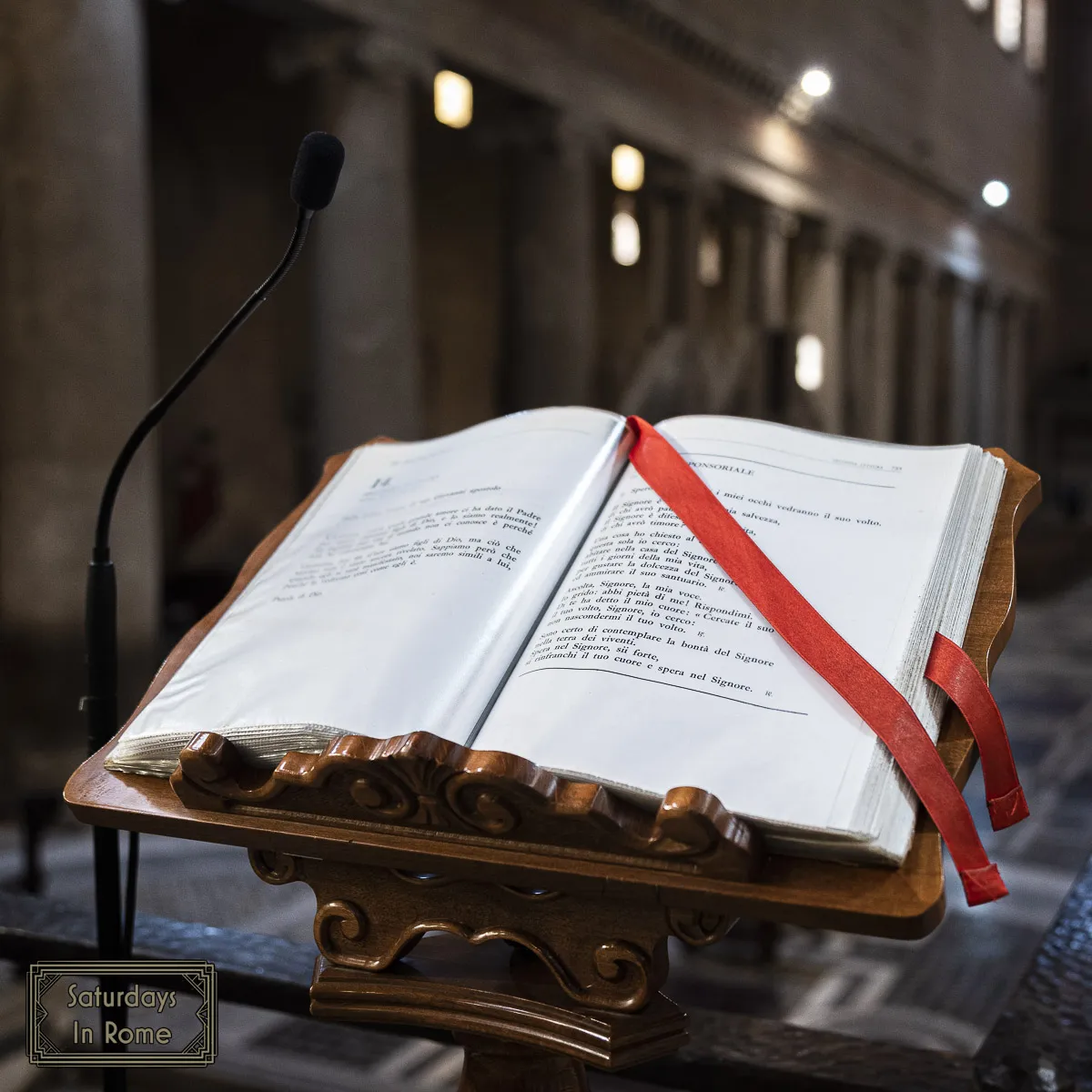
Because the Basilica was built Outside The Walls, which meant that it was built outside of the protective Aurelian Walls, it was at risk of attack by barbarian tribes. Because of this risk, between the 12th and 13th centuries a fortified citadel was formed around the church, surrounded by walls and defense towers. These protections mostly disappeared in the Renaissance age, except for the bell tower (campanile) on the right of the basilica.
The Saint Lawrence Basilica
The central nave of the building became the part of a church reserved for the officiating clergy. To adapt it to this new function, the ancient nave, which originally coincided with the martyr’s sepulcher, was raised by 9 steps, creating space for a small decorated crypt. The wide nave is illuminated by 12 windows on each side, but the narrow aisles are almost dark because the openings are very small.
The aisles are divided by 22 columns, surmounted by Ionic capitals whose distance varies because the shafts are different from each other. There are 6 columns in Cipollino marble, and the remainder are in granite of different levels of quality. There are also inconsistent colors that range from gray to red and from white to black.
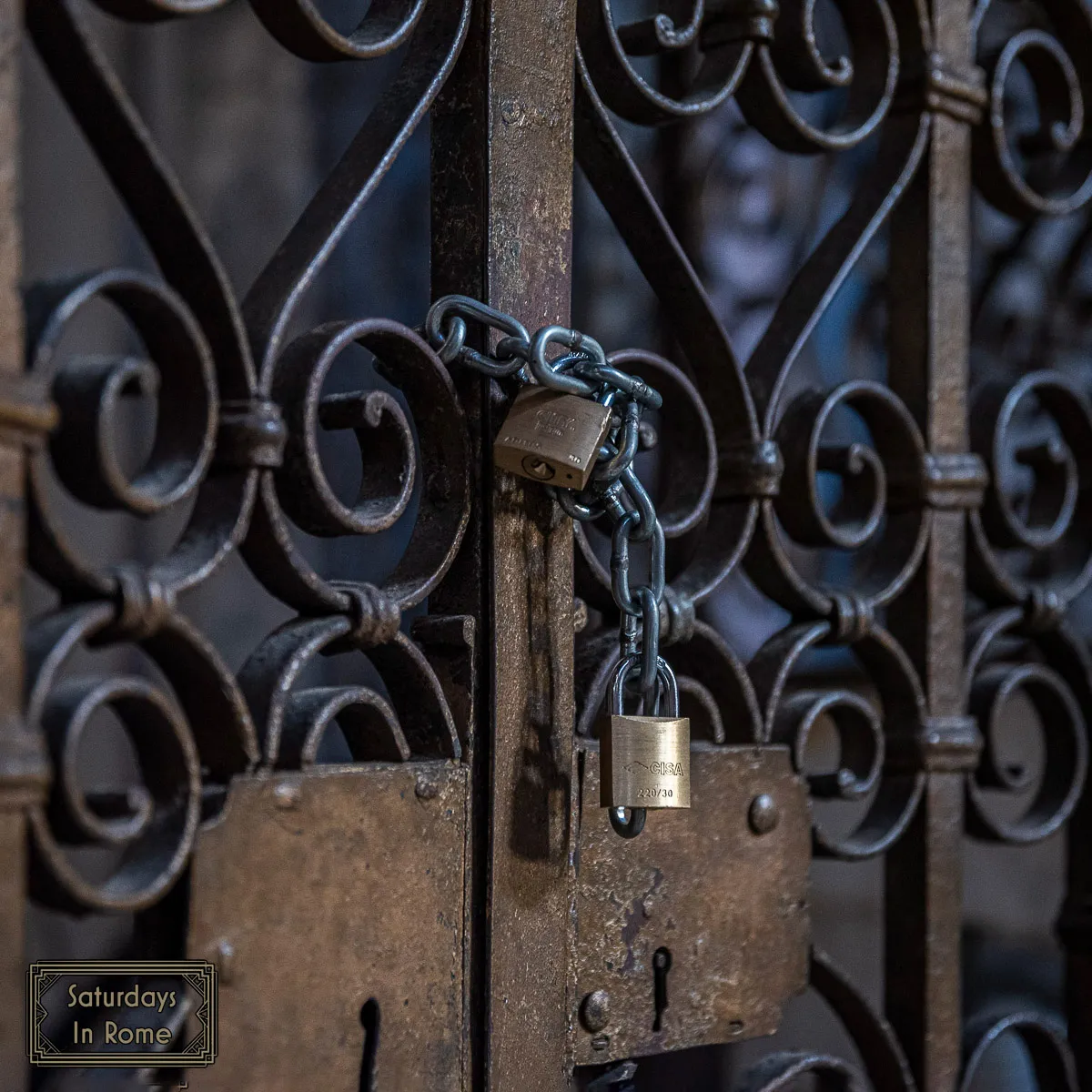
At the bottom of the left aisle there is the entrance to the Catacombs of Ciriaca, so called because they are located on the property of the Roman matron Ciriaca, in which St. Lawrence was buried, so much so that they also had the name of Catacombs of San Lorenzo. The staircase leading to the chapel and the catacombs of St. Ciriaca is decorated with bas-reliefs with the souls in purgatory.
How To Reach The Basilica
If you are arriving at Termini Station, it is an easy, flat 20 minute walk that is approximately a mile away from the station. If you would prefer to take bus, find the #310 (VESCOVIO) and ride it for 5 stops and get off at the UNIVERSITA’/REGINA ELENA stop. You will need to walk for a few minutes until you reach the front of the Basilica and the Verano Cemetery.
You can also walk 4 minutes from Termini to the Volturno bus stop and take the #492 bus 9 stops to Verano, and you will find yourself right outside the basilica. One final option would be if you find yourself near the Colosseum. You can take the #3 tram, which will wind you around the city and you can exit at the Verano stop near the church.
Hours Of Operation
Admission is free, but this church is so close to the cemetery that it is used for funerals frequently. On my first visit to the basilica I was unable to enter because of a funeral, so I returned the following week during normal business hours and the church was mostly empty. You should be flexible when visiting. The hours are:
- Winter: Everyday, 7:30am to 12:30pm, and 3:30pm to 7:00pm
- Summer: Everyday, 7:30am to 12:30pm, and 4:00pm to 8:00pm
Need Help Planning?
- Cheap Flights: Find The Most Affordable Flights.
- Accommodations: From 1 to 5 Stars And More.
- Car Rentals: Affordable Travel Across Italy.
- Sightseeing Tours: Explore Some Amazing Tours.
- Buying An eSIM: Stay Connected In Italy.
This post includes affiliate links.
The Basilica Of Saint Paul Outside The Walls
The Basilica of Saint Paul Outside The Walls (Basilica Papale di San Paolo Fuori le Mura) is one of Rome’s four major papal basilicas, as well as one of the Seven Pilgrim Churches of Rome. It is outside of Vatican City, but is owned by the Holy See and treated as if it is the headquarters of the diplomats of a foreign state.
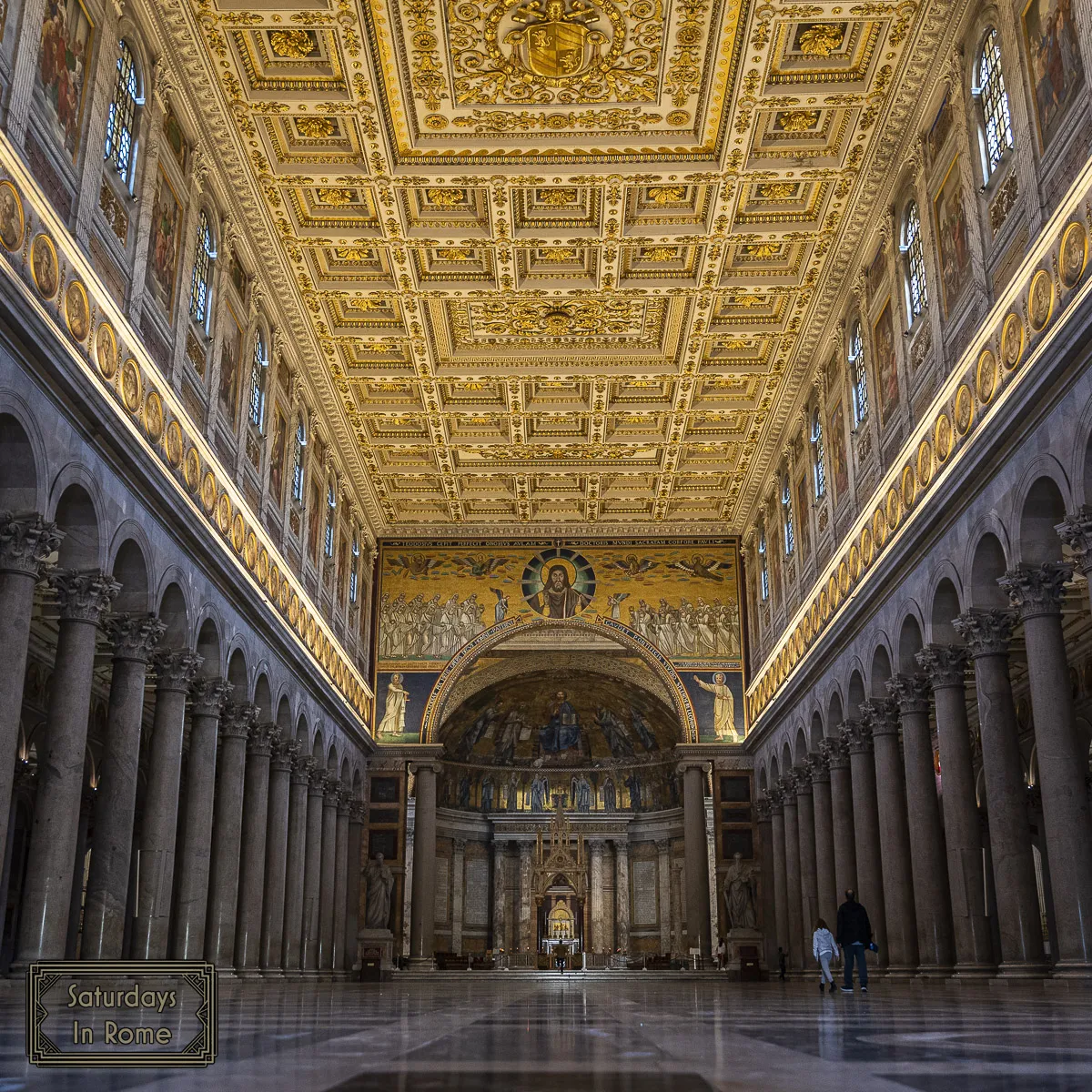
The original basilica was built over the tomb of Saint Paul in 313 AD and Pope Sylvester consecrated it in 330 AD. It was too small to handle the growing number of pilgrims visiting the basilica, so a new basilica was built in 390 AD, which at the time was the largest one in Rome.
This history of this basilica is not without its excitement. Since it is “outside the walls,” in other words outside the protective Aurelian Walls, the basilica was damaged in the 9th century during a Saracen raid. The Pope fortified the protection of the basilica, the monastery, and the peasant housing, forming the town of Johannispolis which existed until 1348, when an earthquake totally destroyed it.
In 1823, a worker repairing the copper gutters of the roof started a fire that led to the near-total destruction of this basilica, which had preserved much of its original character for 1435 years. In 1825, Pope Leo XII issued orders that the basilica be rebuilt exactly as it had been when new in the fourth century and medieval mosaics and the tabernacle also be repaired and retained.
The Basilica Of St Paul Outside The Walls
The Basilica is one of the more dramatic settings of the churches that I’ve visited in Rome. The scale is grand and made even more so by the importance of the tomb of Saint Paul, and how empty the space is. The entire basilica should be visited, but the two most surprisingly beautiful spaces are the Quadriportico and the Nave.
The Quadriportico
The quadriportico is a porticoed garden measuring 230 feet square surrounded by 150 columns of white granite from Montorfano, near lake Como. There is a statue in the center of the garden by Giuseppe Obici from around 1850. The statue represents St. Paul with a longsword in his right hand. representing the instrument of his martyrdom. In his left hand he holds the book of the epistles.
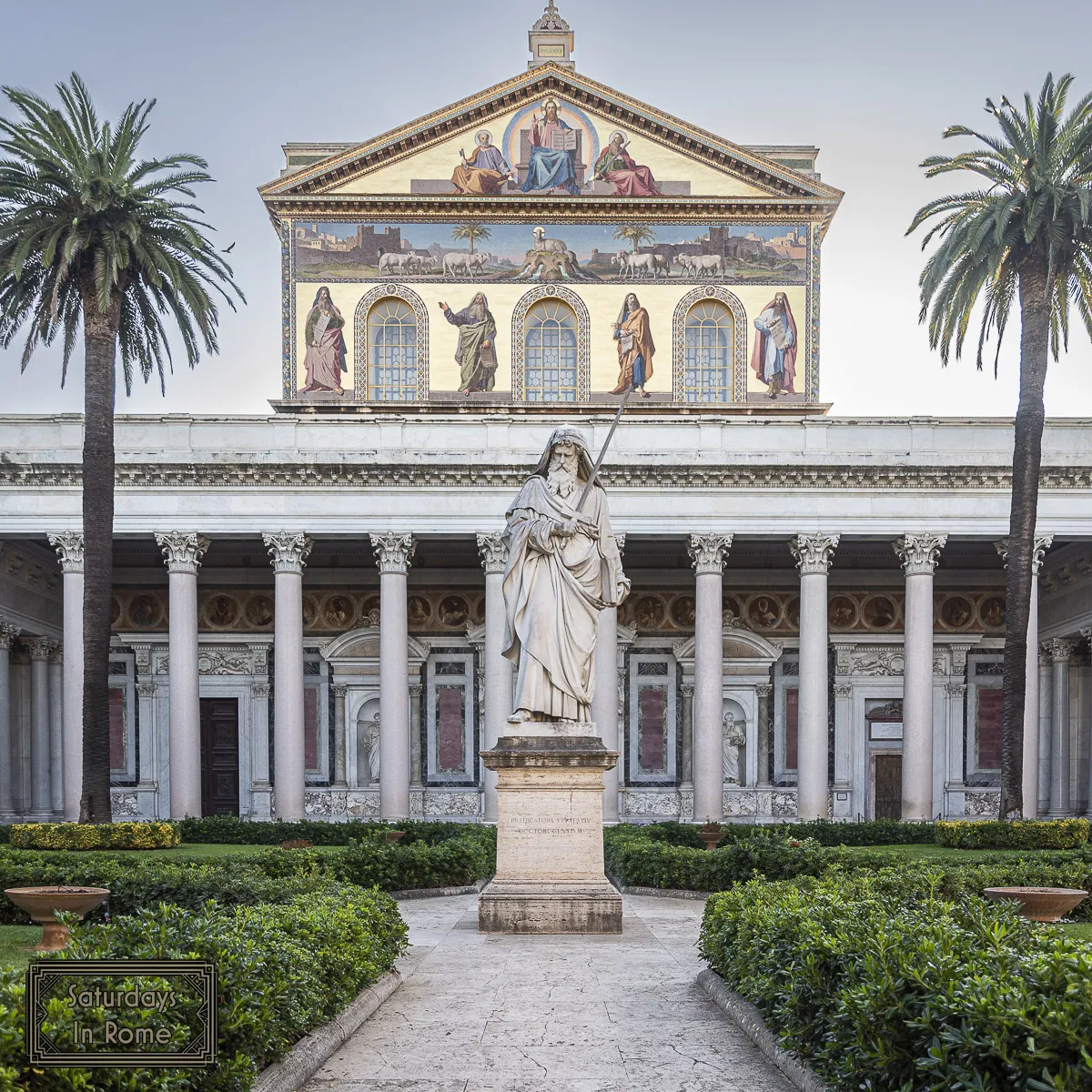
In the four corners of the garden (quadriportico) are pedestals only one of which is occupied by a statue. It is the work of Francesco Fabi-Altini (1893). It represents Saint Luke, companion of Paul and author of the Acts of the Apostles.
The central door is by Antonio Maraini, and was made between 1929 and 1931. It is a bronze double door weighing around 8 tons. The iconography aims to celebrate the preaching of the two apostles of Rome within the framework of a cross. Scenes from the lives of SS. Peter and Paul are portrayed on the two doors, and to my eyes, the top panels, given the timing of the creation, look to have iconography similar to others from the Fascist period.
The Nave
The nave was really surprising to be both because of its grand scale, but also because of its emptiness. The space is more than 440 feet long, around half as wide and 100 feet high. There are two outer aisles that are separated by four rows of twenty columns made of the same Montorfano granite. There are no chairs, pews or really anything else in the center space, and only a couple of short benches along the two outer aisles.
Two large statues of St Paul, by Salvatore Revelli, and of St Peter, by Ignazio Jacometti, are found near the columns of the arch. The other apostles, dating from 1882, are in the niches of the lateral walls. There is a chronological series of Pope portraits from the fifth century that were, for the most part, destroyed by the fire and remade between 1848 and 1876.
How To Reach The Church Of St Paul Outside The Walls
The easiest way to reach the basilica is on Metro B. You can get that at Termini station, or a stop closer if it is more convenient, and take it to the Basilica S. Paolo stop. There are also bus lines, #23 and #769, that will drop you right by the basilica.
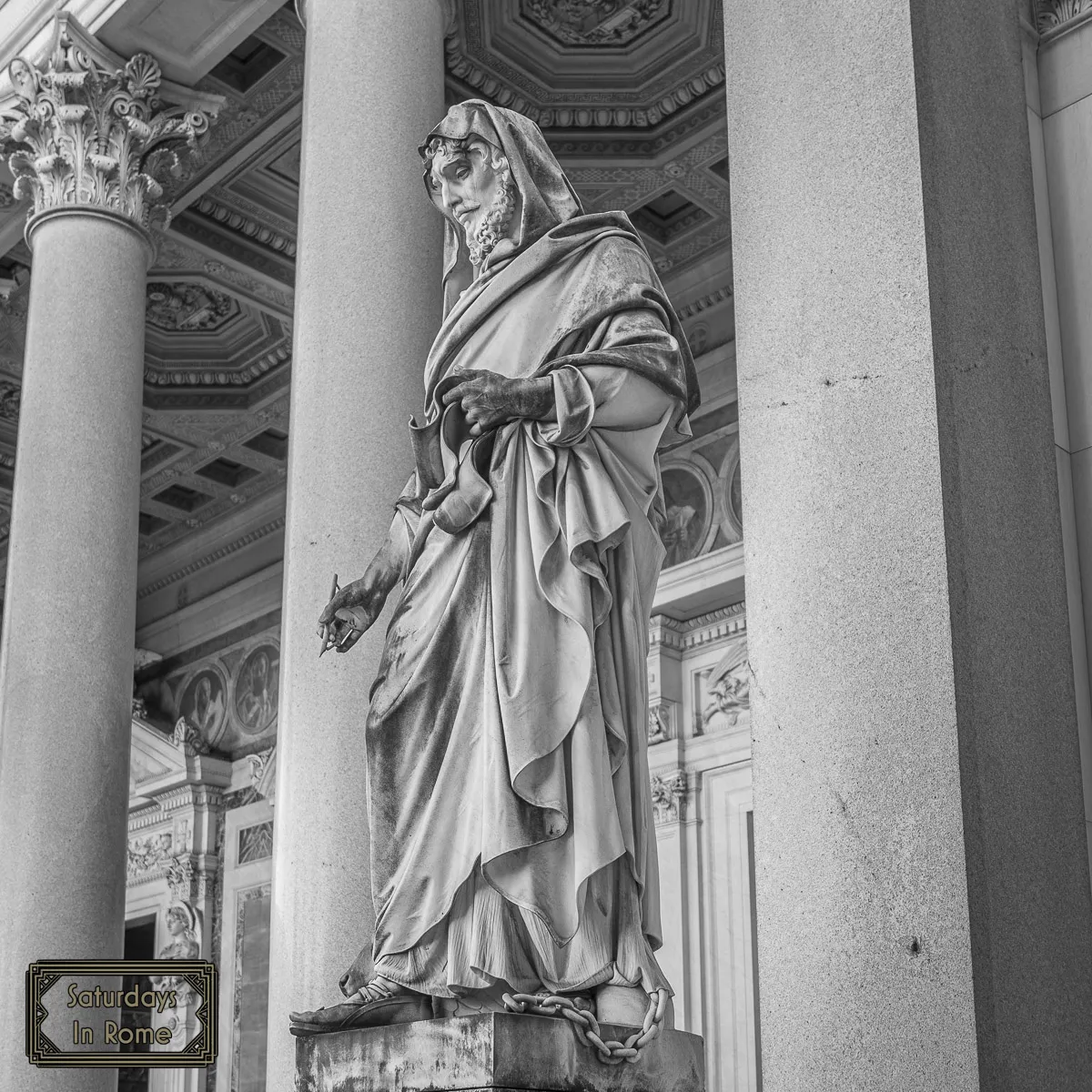
Hours Of Operation
In addition to the Basilica, there is a Cloister, an archaeological area, a souvenir shop and a bar if you need a snack. The hours are:
- The Basilica is open every day from 7:00 am to 7:00 pm, free admission
- The Cloister is open every day from 9:00 am to 5:30 pm, admission € 4.00 (reduced € 3.00)
- The Souvenir Shop is open every day from 8:00 am to 7:00 pm
- The Sacristy is open every day from 8:00 am to noon and from 4:00 pm to 6:30 pm
- The Bar is Open every day from 8:00 am to 7:00 pm
The Basilica Of The Holy Cross In Rome
The Basilica of The Holy Cross in Rome is one of the Seven Pilgrim Churches of Rome. It is located in Esquilino, one of the districts in Rome, Italy near the Aurelian Walls and it is not far from another of the Seven Churches, the Basilica of St. John Lateran.
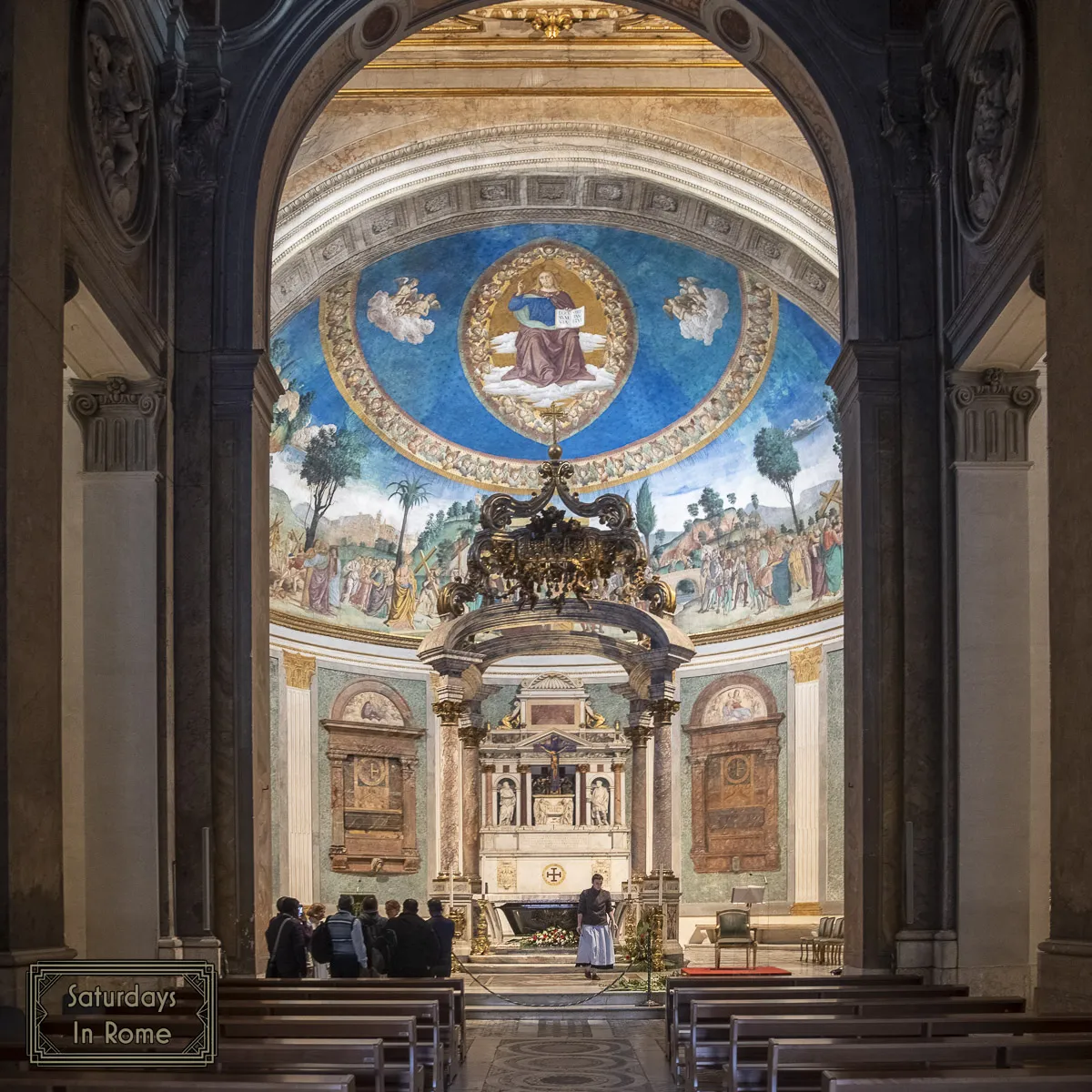
Relics Of The True Cross
The Basilica of the Holy Cross is home to “Relics of the True Cross”, which tradition says are the fragments of the “True Cross” (the cross on which Jesus is believed to have been crucified) and one of the nails used in the Crucifixion of Jesus Christ that Saint Helen brought to Rome after her pilgrimage to the Holy Land.
In order to earn the title in Jerusalem, the basilica’s floor was covered with soil from the holy city. The basilica was considered to be “in Jerusalem” in a similar way that an embassy is considered extraterritorial, i.e. “In” the country.
Basilica Of The Holy Cross in Jerusalem Relics
The Holy Relics are small pieces from the Passion of Christ that have been preserved in gold covered reliquaries (container for relics) from the 19th century. They are protected by a glass case and displayed for the many pilgrims and visitors that come to the Basilica.
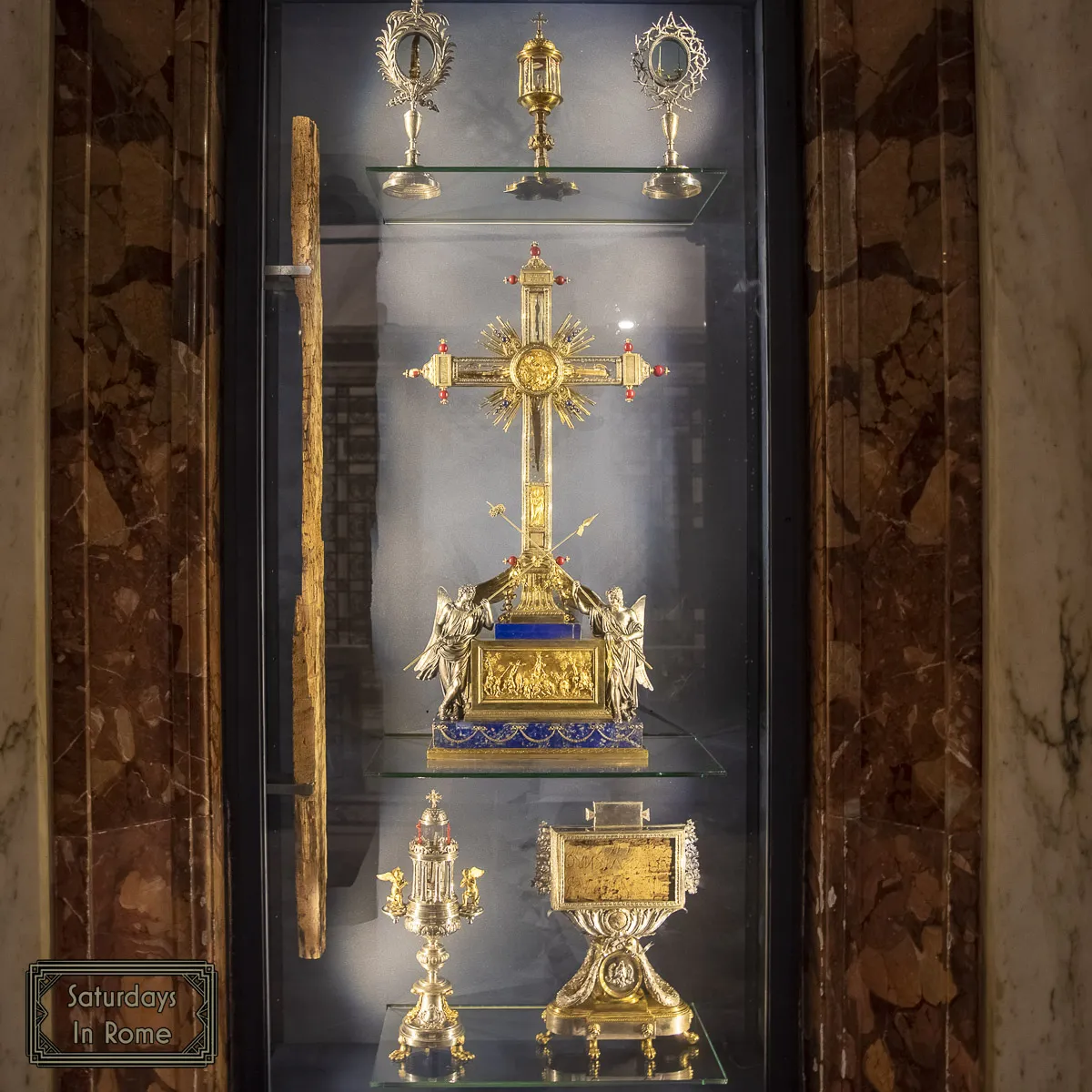
The Catholic tradition says that St. Helen, mother of Emperor Constantine, brought some relics to Rome after her pilgrimage, and the collection has grown to include:
The Fragments of the True Cross (from St. Helen)
One of the nails used in the Crucifixion (from St. Helen)
Fragments of the Grotto of the Nativity and the Holy Sepulcher
The joint of the finger of St. Thomas
A part of the cross of the Good Thief
Two thorns from the Crown of Jesus
In the same display case is kept the Titulus Crucis, which is believed to be the actual wooden tablet that was on top of Jesus’ cross. It is thought to have been brought to the Basilica in the 6th century and discovered during the restoration works of the 15th century. The tablet is written from right to left in Hebrew, Greek and Latin characters.
There are some doubts about the authenticity of the Titulus Crucis. In 2002, radiocarbon dating tests were conducted on the tablet and it was shown to have been made between 980 and 1146 AD. The Titulus Crucis is most likely a medieval copy.
In a book written in the 13th century, it is written that Helen rescued more than a cross on Golgotha and to determine which one belonged to Jesus she touched a deceased mane with the wood of the cross, and upon touching the True Cross, the man was resurrected.
The Nennolina Story
Antonietta Meo, affectionately called “Nennolina”, was born in Rome on December 15th of the year 1930. At six years old, she was struck by osteosarcoma, forcing her left leg to be amputated. Already at that age, she had a concept of the value of suffering that was attributed to her belief in God. She is considered an inspiration because she dealt with her intense physical pain through her relationship with her higher power.
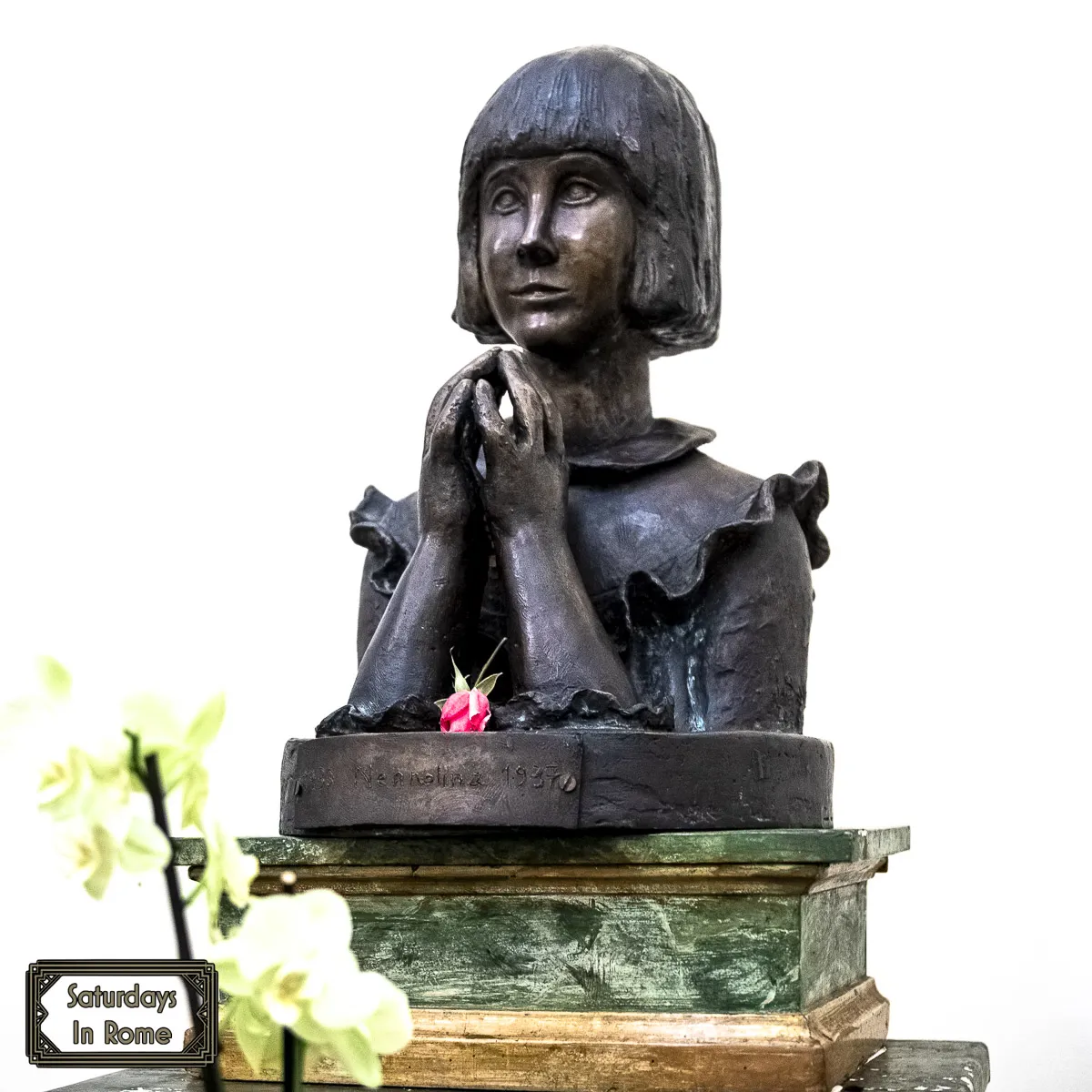
In the Basilica is the Chapel Of Antonietta Meo, which looks to contain her tomb, some clothes and toys that she may have used during her short life. The sign outside the chapel has a sign reading:
“From 5th of July 1999, the mortal remains of Antonietta Meo – “Nennolina” (12.15.1930 – 07.03. 1937) rest at the foot of the Chapel. She was a child who lived a few hundred meters from the Basilica in the Thirties and died at the age of six and a half from osteosarcoma. Her short life was so deeply marked by the mystery of the Cross that a story of ordinary pain was turned into an extraordinary one. Her 162 letters addressed to God the Father, Jesus, to the Holy Spirit and to dear Virgin Mary testify this and make little Nennolina the youngest mystic remembered by the Church.”
Hours Of Operation
Admission is free, but this church is actively used and may be unexpectedly closed to tourists. On my first visit to the basilica I was unable to enter because of a funeral, so I returned the following day during normal business hours and the church was mostly empty. You should always be flexible when visiting any of the important sites in Rome. The hours are: Everyday, 7:00am to 12:45pm, and 3:30pm to 7:30pm
Need Help Planning?
- Cheap Flights: Find The Most Affordable Flights.
- Accommodations: From 1 to 5 Stars And More.
- Car Rentals: Affordable Travel Across Italy.
- Sightseeing Tours: Explore Some Amazing Tours.
- Buying An eSIM: Stay Connected In Italy.
This post includes affiliate links.
The Basilica Of St. Sebastian Outside The Walls
As one of the classic 7 Pilgrim Churches of Rome, the Basilica of San Sebastian Outside The Walls and the Catacombs is an inspirational site to visit.
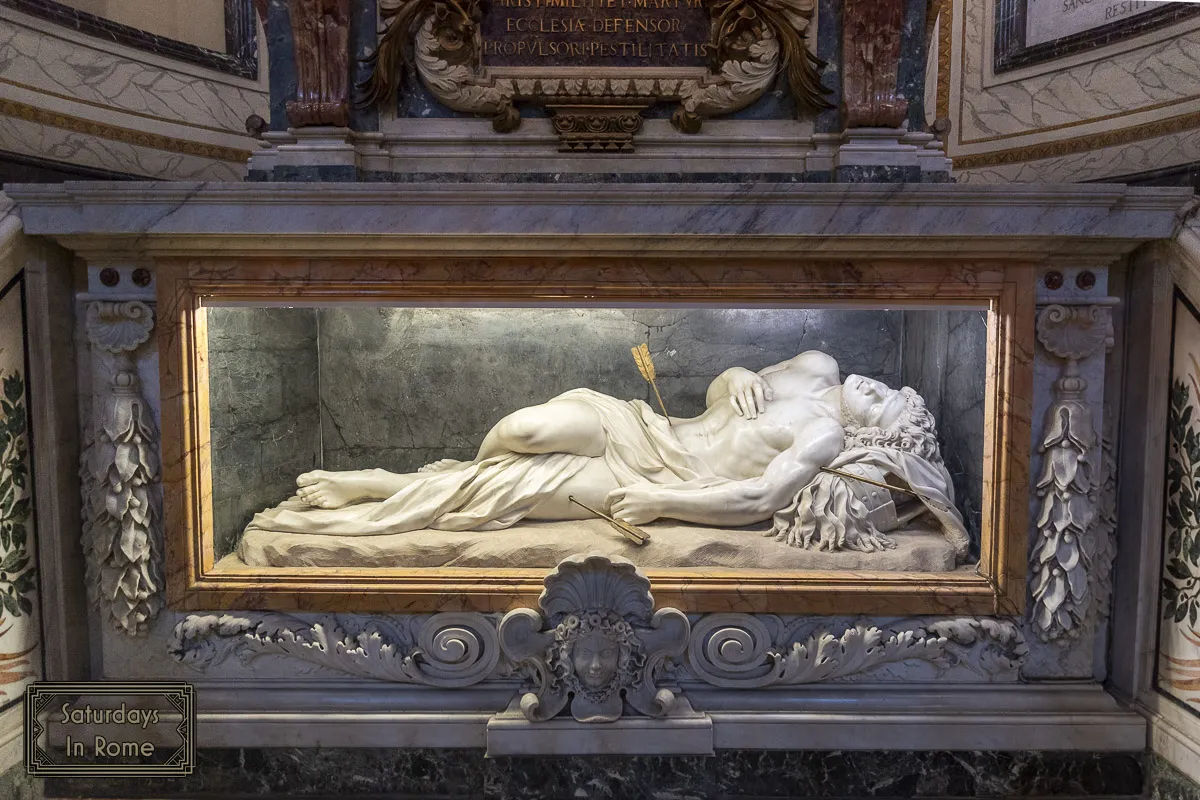
Why Is The Basilica Of St. Sebastian Outside The Walls Significant?
The Basilica itself, in my opinion, is actually pretty unremarkable apart from the beautiful Baroque style wooden ceiling that is worth admiring. The significance of the Basilica is in the attached catacombs. These are the largest and best known of the Christian cemeteries in Rome. The Basilica used to contain the remains of San Sebastian, but because the church lay outside the Aurelian Walls, and was at risk of being attacked, the remains were moved to St. Peter’s Basilica.
In addition to the ceiling in the Basilica, there are some relics and art that are also worth noting:
- The footprints that are believed to be left by Jesus at the time of the Domine quo vadis?
- One of the arrows that struck San Sebastiano
- The Albani Chapel (1706-1712)
- The lying statue of San Sebastiano, designed by Gian Lorenzo Bernini.
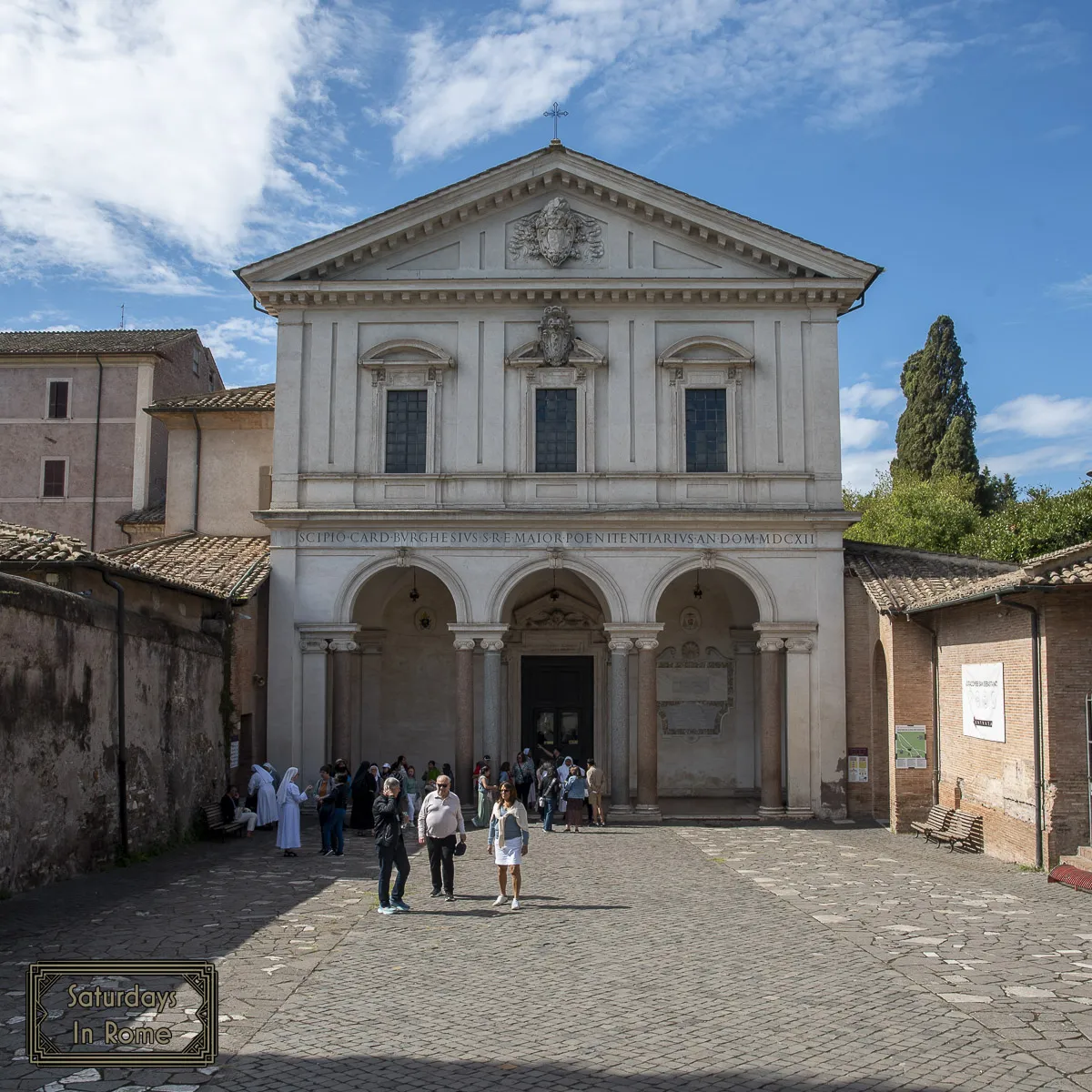
Why Are The Saint Sebastian Catacombs Famous?
The Saint Sebastian catacombs in Rome and an underground cemetery along the Appian Way outside the Aurelian Walls. The name Catacombs is claimed to have originated with these catacombs, which were originally built in a tufa excavation site. Im Greek, katà and kymbe, literally mean “close to the cavity”, which referred to the giant hole of the mine.
The history of these catacombs date back to the second century when they were used as a pagan burial site. Later they held the remains of Apostles Peter and Paul, and later San Sebastian.
As often happened in ancient times, the quarry and pagan cemetery was taken over by Christians and turned into their cemetery. They created a network of more than 7 miles (12 km) of underground tunnels divided into three levels. There were smaller niches that allowed for the burial of urns, larger holes that fit the bodies of the deceased in the fetal position, as well as larger crypts that could hold entire families.
When I was looking at the events of the Jubilee 2025, I noticed they list the original seven churches as the official version, leaving off the Sanctuary. I could not find any information online regarding the change back, so I asked the tour guide if San Sebastian is on the list, and she said it was and that Pope Benedict had made the change. I still can’t find anything official on this, so I suspect this is more regarding some of the more devout respecting the original 7 and not the updated version. Whatever the reason, if you have any information, please let me know!
The Sanctuary Of The Madonna Of The Divine Love (Optional)
Also known as the Shrine of Our Lady of Divine Love, this Roman Catholic shrine is dedicated to the Virgin Mary and it is south of Rome, Italy and slightly beyond the Grande Raccordo Anulare (GRA). It is believed to be the site of divine intervention (described below) and is one of the seven pilgrim churches of Rome.
The Sanctuary of the Madonna of the Divine Love was made part of the pilgrimage route by Pope John Paul II in 2000. Prior to that, the minor basilica St. Sebastian Outside The Walls was one of the seven churches, until it was replaced. Today, the classic Seven that Pilgrims enjoy includes St. Sebastian, making the Sanctuary of the Madonna optional.
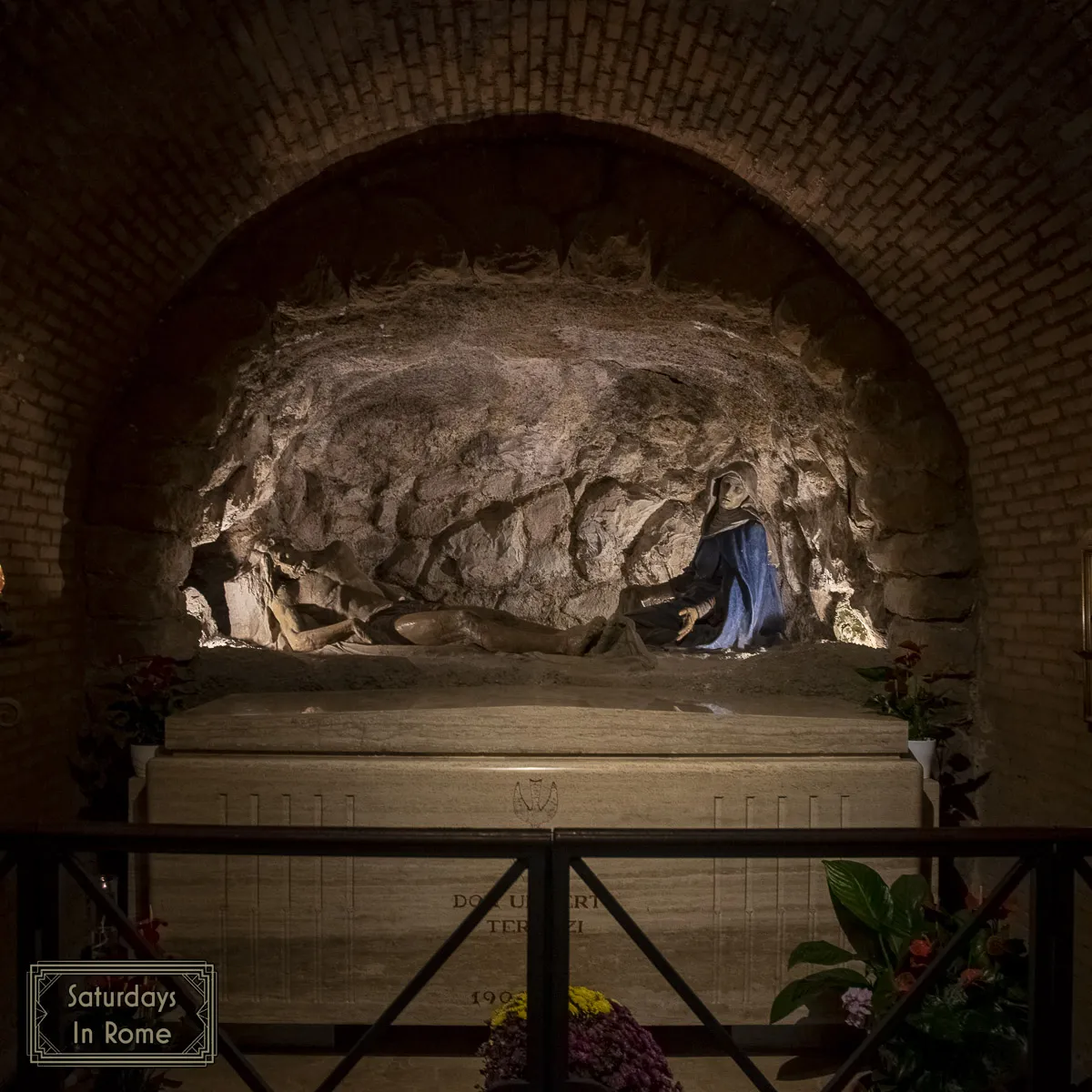
Divine Intervention
The shrine is in celebration of the Virgin Mary and acts of God’s Divine Intervention that have taken place on the site. The story of the first divine intervention goes like this:
On a spring day in 1740. A traveler thought to be a pilgrim heading to St. Peter’s Basilica gets lost on the deserted country paths more than a half-dozen miles south of Rome. As he is about to enter the Castel di Leva he is attacked by a pack of wild dogs.
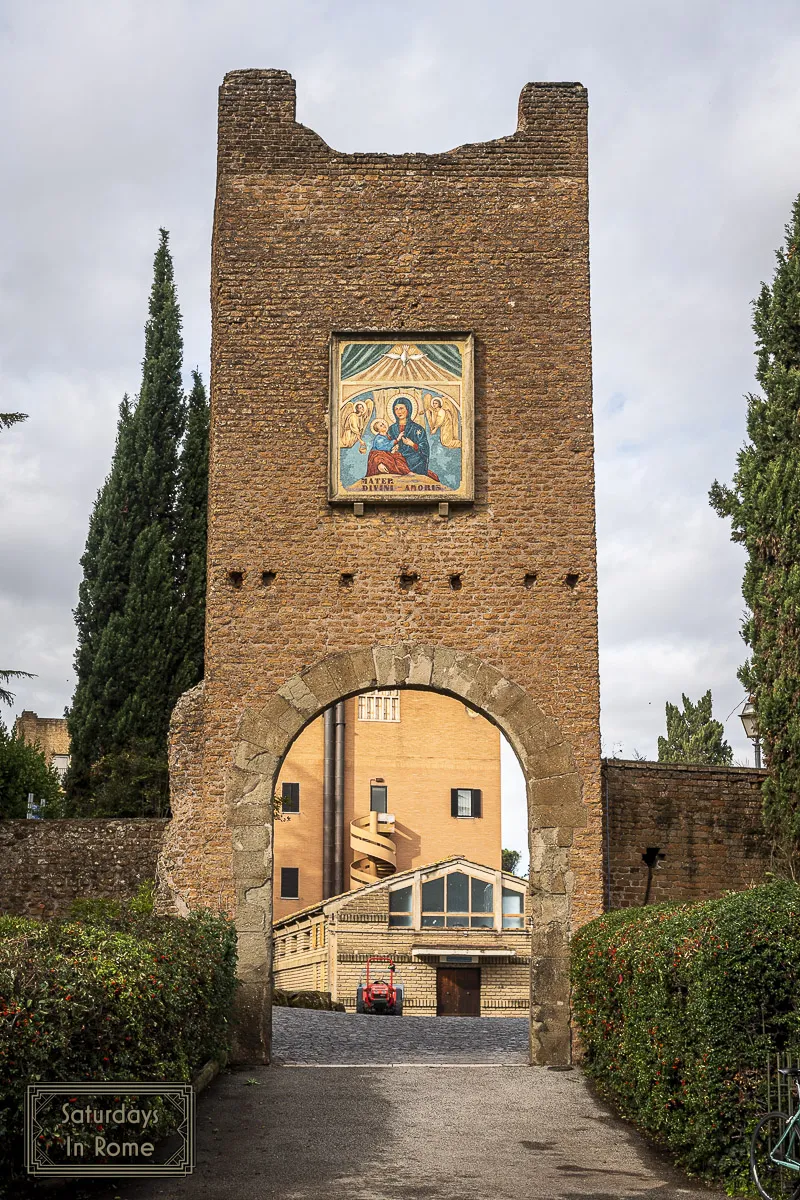
The angry dogs surround him and are ready to attack. Terrified, the poor man looks up and realizes that there is a sacred image of the Virgin Mary on the tower. Like a shipwrecked man who clings to her boat with all the strength he is capable of, he shouts: “My God, grace!”.
It’s a moment. The dogs, which are now upon him, suddenly stop. It almost seems that they are obeying a mysterious order. At the call of that desperate cry, the shepherds who are nearby rush and, after hearing that incredible story, put the pilgrim back on the road to Rome.
Places of Prayer Around The Sanctuary Of Our Lady Of Divine Love
Of the collection of seven churches of the pilgrim’s trail, this sanctuary is by far the largest, apart from Vatican City. It is a sprawling campus on rolling hills that include an outdoor prayer space, a couple of caves, a new church and other chapels.
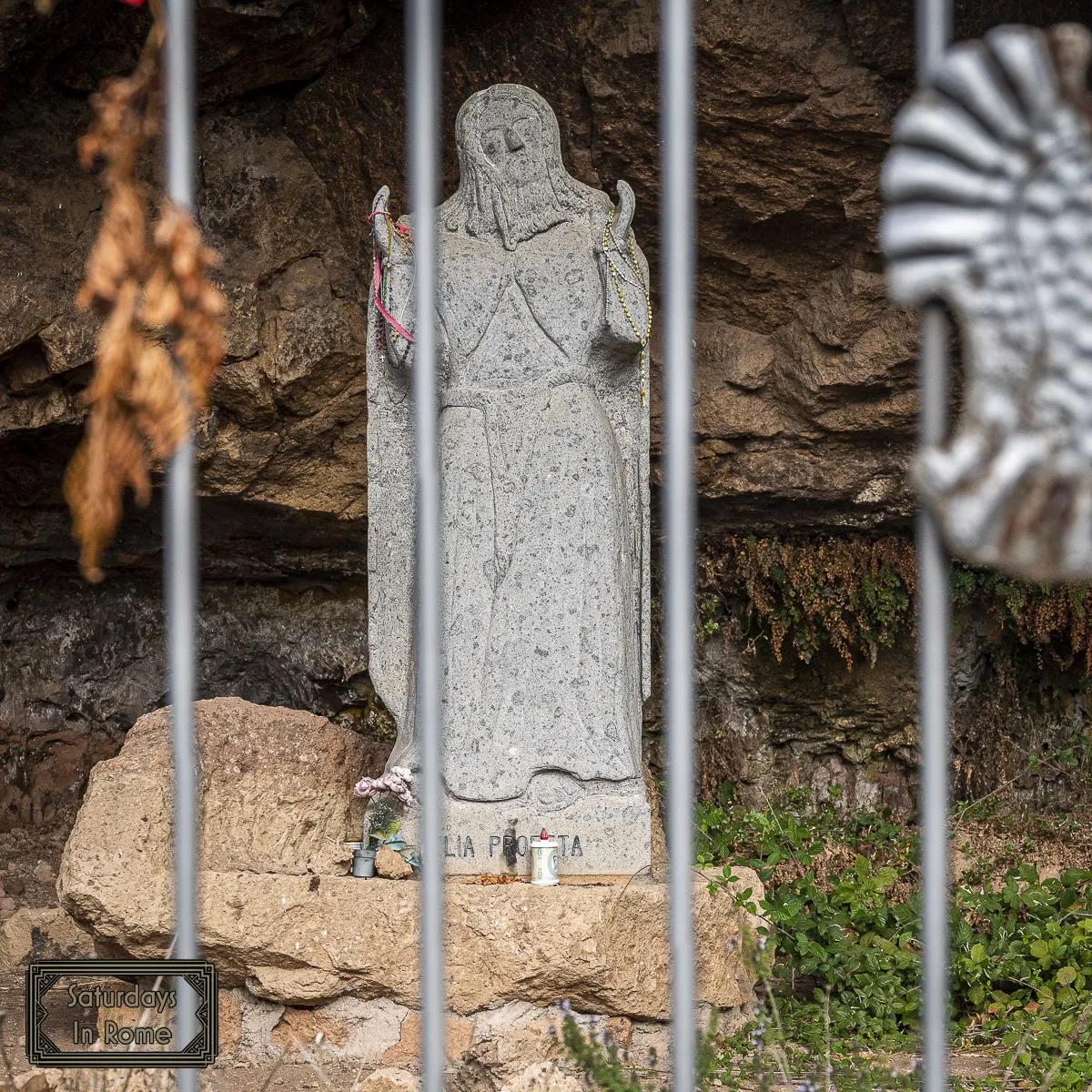
As I mentioned, there were actually two different and unrelated masses being celebrated during my visit and there was still more than enough to enjoy while walking around the beautiful grounds. These include:
- The Tower of the First Miracle – As mentioned above, this was the location of the fresco of the Virgin of Divine Love and was what the traveler prayed to. The original fresco is now kept in the Ancient Sanctuary.
- The Ancient Sanctuary – Unfortunately for me, this was one of the churches that had a mass underway at the time of my visit, so I only took pictures of the exterior. It was built in 1744 and now houses the fresco that was originally on the Tower of the First Miracle.
- The New Sanctuary – This church is probably one of the most modern looking ones that I’ve seen in Rome. It took more than 10 years to build and was completed in 1999. Since 2007, it has been kept open day and night for Perpetual Eucharistic Adoration.
- The Crypt – This was originally a cistern of the ancient medieval castle and in 1947 was made into a church. In the semi-dome above the altar (the Apse) there is a mosaic and in the back, beyond the tomb of Don Umberto Terenzi are statues of the Virgin of Sorrows and a dead Jesus.
- The Open-Air Church – Although in a bit of disrepair during my visit, the open-air church has mother earth for the floor, the sky for the dome and the course of the sun for orientation. Respecting the nomadic tradition, the “Sanctuary of the Gypsies” is designed outdoors.
- The Cave of Elijah – This grotto was inaugurated in 2007 and is a cave of Tufa stone that is dedicated to the Prophet Elijah who took refuge in a cave and had an encounter with God when he heard the wind.
There are other places of prayer scattered around the property, but I felt like these were the most interesting and dramatic for a visitor looking for their first intervention by the divine.
Hours Of Operation
Admission is free, but this church is actively used and may be unexpectedly closed to tourists. On my first visit to the basilica I was unable to enter a couple of the chapels because of masses that were underway, so I focused on the other sites, and there are many. You should always be flexible when visiting any of the important sites in and around Rome. The office is open everyday from 9:00 AM until noon and again from 4:00 PM until 6:45 PM, Holidays included.
More On The Classic Seven Pilgrim Churches In Rome
If you have enjoyed this article on The Seven Pilgrim Churches In Rome and you would like more information, you may find these individual posts and hidden gems interesting and worthy of a visit as well:
- Top Sites to See in Rome: Our Complete Guide.
- The Roman Colosseum: An Icon of The Ancient World.
- Exploring Rome Parks: A Guide to the City’s Greenspaces.
- Exploring The Great Churches of Rome One Altar At A Time.
- Understanding Rome’s Neighborhoods For The First Time Visitor.
- The Beautiful Rome Fountains You Must See On Your Next Visit.
- Egyptian Obelisks In Rome Need To Be On Your Itinerary.
- Modern Sites In Rome: Contemporary Sites Worth Visiting.
- Ancient Sites In Rome – Exploring the Most Important Sites.
- Beautiful Places In Rome, Italy That Shouldn’t Be Missed.
- Bad Tourist Behavior In Italy Needs To Be Avoided By All.
- Finding The Basilica of Saint Lawrence Outside The Walls.
- The Basilica of Saint Mary Major.
- The Enduring History Of The Basilica Of St. John Lateran.
- The Papal Basilica of St. Paul Outside the Walls.
- The Basilica Of The Holy Cross In Rome Needs To Be Seen.
- The Vatican And St. Peter’s Basilica Shouldn’t Be Missed.
- The Basilica Of St. Sebastian Outside The Walls (Classic)
- The Sanctuary of Our Lady of Divine Love In Rome, Italy. (Optional)
